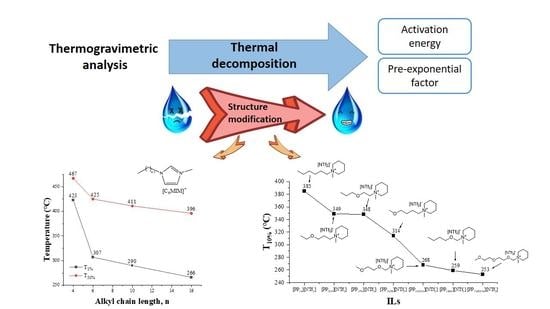Thermal Stability of Ionic Liquids: Current Status and Prospects for Future Development
Abstract
1. Introduction
2. Measurement of Thermal Stability
2.1. Short-Term Thermal Stability
2.2. Long-Term Thermal Stability
2.3. Factors Affecting TGA Results
2.3.1. Heating Rates
2.3.2. Gas Atmosphere
2.3.3. Impurities
3. Kinetics of Thermal Decomposition
3.1. Isoconversional Methods
3.1.1. Differential Isoconversional Methods
3.1.2. Integral Isoconversional Methods
3.1.3. Maximum-Rate Methods
3.2. Arrhenius Methods
3.3. Determining the Pre-Exponential Factor
3.3.1. Using Compensation Effect
3.3.2. Using Master Plots
4. Influence of Chemical Structure on Thermal Stability
4.1. Influence of Alkyl Chain Length
- (1)
- (2)
- Carbocations and carbon radicals with longer alkyl chains are more stable and easier to leave on heating, and thus ILs with longer alkyl chains favor the decomposition phenomenon [72];
- (3)
- For choline based amino acid ILs, longer alkyl chains on cation create strong hydrophobic interaction with gradually decreased hydrogen bond interaction due to bulkier cationic size. Upon decreasing alkyl chain length, the reverse effect renders lowering the overall thermal stability of the ILs [77].
4.2. Influence of Functionalization and Alkyl Substituents
| ILs | Structure of Cations | Tonset/°C | Reference |
|---|---|---|---|
| [C2NH2MMIM][BF4] |  | 284 | [101] |
| [C2MMIM][BF4] |  | 391 | [101] |
| [C2NH2MIM][Br] |  | 222 | [113] |
| [C2MIM][Br] |  | 300 | [71] |
| [C7MIM][NTf2] |  | 437 | [110] |
| [BnzMIM][NTf2] |  | 421 | [110] |
| [(Bnz)2IM][NTf2] |  | 410 | [110] |
| [NapmMIM][NTf2] |  | 406 | [110] |
4.3. Influence of Anions and Cations
5. Thermal Stability of Some Novel ILs
5.1. ILs Mixtures
5.2. Dicationic ILs
6. Summary
Author Contributions
Funding
Data Availability Statement
Conflicts of Interest
Nomenclature
| A | Pre-exponential factor, min−1 |
| Isoconversional values of pre-exponential factor, min−1 | |
| E | Activation energy, kJ mol−1 |
| Isoconversional values of the activation energy, kJ mol−1 | |
| Kinetic model function | |
| Integral kinetic model function | |
| Rate constant | |
| Number of compounds presented in the mixture | |
| Mass at a certain time | |
| End mass of the sample | |
| Initial mass | |
| Experimental mass loss of each IL forming the mixture at each temperature | |
| Mixture mass lose in an ideal case at each temperature | |
| MOT | Maximum operating temperature, °C |
| R | Universal gas constant, 8.314 J mol−1 K−1 |
| tmax | Maximum operation time |
| Tonset | Onset decomposition temperature, °C |
| Tpeak | Temperature of maximum degradation, °C |
| T50% | Temperature at the decomposition degree of 50%, °C |
| Tz | Temperature at the decomposition degree z, °C |
| T0.01/10h | Temperature at decomposition degree of 0.01 within 10 h, °C |
| Tz/y | Temperature at decomposition degree z within the selected time y, °C |
| Temperature at which the first appreciable weight loss occurs, K | |
| Each IL mass fraction in the mixture | |
| Greek Symbols | |
| α | Extent of conversion |
| β | Heating rate, °C min−1 |
| Subscripts | |
| α | Different extent of conversion |
| i | Different temperature programs |
| All heating programs other than | |
References
- Egorova, K.S.; Ananikov, V.P. Fundamental Importance of Ionic Interactions in the Liquid Phase: A Review of Recent Studies of Ionic Liquids in Biomedical and Pharmaceutical Applications. J. Mol. Liq. 2018, 272, 271–300. [Google Scholar] [CrossRef]
- Qiao, Y.; Ma, W.; Theyssen, N.; Chen, C.; Hou, Z. Temperature-Responsive Ionic Liquids: Fundamental Behaviors and Catalytic Applications. Chem. Rev. 2017, 117, 6881–6928. [Google Scholar] [CrossRef]
- Boruń, A. Conductance and Ionic Association of Selected Imidazolium Ionic Liquids in Various Solvents: A Review. J. Mol. Liq. 2019, 276, 214–224. [Google Scholar] [CrossRef]
- Ichikawa, T.; Kato, T.; Ohno, H. Dimension Control of Ionic Liquids. Chem. Commun. 2019, 55, 8205–8214. [Google Scholar] [CrossRef]
- Jiang, S.; Hu, Y.; Wang, Y.; Wang, X. Viscosity of Typical Room-Temperature Ionic Liquids: A Critical Review. J. Phys. Chem. Ref. Data 2019, 48, 033101. [Google Scholar] [CrossRef]
- Götz, M.; Reimert, R.; Bajohr, S.; Schnetzer, H.; Wimberg, J.; Schubert, T.J.S. Long-Term Thermal Stability of Selected Ionic Liquids in Nitrogen and Hydrogen Atmosphere. Thermochim. Acta 2015, 600, 82–88. [Google Scholar] [CrossRef]
- Amde, M.; Liu, J.-F.; Pang, L. Environmental Application, Fate, Effects, and Concerns of Ionic Liquids: A Review. Environ. Sci. Technol. 2015, 49, 12611–12627. [Google Scholar] [CrossRef] [PubMed]
- Ghandi, K. A Review of Ionic Liquids, Their Limits and Applications. Green Sustain. Chem. 2014, 4, 44–53. [Google Scholar] [CrossRef]
- Rybińska-Fryca, A.; Mikolajczyk, A.; Łuczak, J.; Paszkiewicz-Gawron, M.; Paszkiewicz, M.; Zaleska-Medynska, A.; Puzyn, T. How Thermal Stability of Ionic Liquids Leads to More Efficient TiO2-Based Nanophotocatalysts: Theoretical and Experimental Studies. J. Colloid Interface Sci. 2020, 572, 396–407. [Google Scholar] [CrossRef]
- Elhamifar, D.; Kazempoor, S.; Karimi, B. Amine-Functionalized Ionic Liquid-Based Mesoporous Organosilica as a Highly Efficient Nanocatalyst for the Knoevenagel Condensation. Catal. Sci. Technol. 2016, 6, 4318–4326. [Google Scholar] [CrossRef]
- Giacalone, F.; Gruttadauria, M. Covalently Supported Ionic Liquid Phases: An Advanced Class of Recyclable Catalytic Systems. ChemCatChem 2016, 8, 664–684. [Google Scholar] [CrossRef]
- Oh, Y.-H.; Jang, H.B.; Im, S.; Song, M.J.; Kim, S.-Y.; Park, S.-W.; Chi, D.Y.; Song, C.E.; Lee, S. SN2 Fluorination Reactions in Ionic Liquids: A Mechanistic Study towards Solvent Engineering. Org. Biomol. Chem. 2010, 9, 418–422. [Google Scholar] [CrossRef] [PubMed]
- Bouvet, S.; Pégot, B.; Marrot, J.; Magnier, E. Solvent Free Nucleophilic Introduction of Fluorine with [Bmim][F]. Tetrahedron Lett. 2014, 55, 826–829. [Google Scholar] [CrossRef]
- Newington, I.; Perez-Arlandis, J.M.; Welton, T. Ionic Liquids as Designer Solvents for Nucleophilic Aromatic Substitutions. Org. Lett. 2007, 9, 5247–5250. [Google Scholar] [CrossRef] [PubMed]
- Khan, A.S.; Man, Z.; Bustam, M.A.; Kait, C.F.; Ullah, Z.; Nasrullah, A.; Khan, M.I.; Gonfa, G.; Ahmad, P.; Muhammad, N. Kinetics and Thermodynamic Parameters of Ionic Liquid Pretreated Rubber Wood Biomass. J. Mol. Liq. 2016, 223, 754–762. [Google Scholar] [CrossRef]
- Reina, L.; Botto, E.; Mantero, C.; Moyna, P.; Menéndez, P. Production of Second Generation Ethanol Using Eucalyptus Dunnii Bark Residues and Ionic Liquid Pretreatment. Biomass Bioenergy 2016, 93, 116–121. [Google Scholar] [CrossRef]
- Gregorio, G.F.D.; Weber, C.C.; Gräsvik, J.; Welton, T.; Brandt, A.; Hallett, J.P. Mechanistic Insights into Lignin Depolymerisation in Acidic Ionic Liquids. Green Chem. 2016, 18, 5456–5465. [Google Scholar] [CrossRef]
- Wang, W.; Ma, X.; Grimes, S.; Cai, H.; Zhang, M. Study on the Absorbability, Regeneration Characteristics and Thermal Stability of Ionic Liquids for VOCs Removal. Chem. Eng. J. 2017, 328, 353–359. [Google Scholar] [CrossRef]
- Zhang, W.; Ye, L.; Jiang, J. CO2 Capture with Complex Absorbent of Ionic Liquid, Surfactant and Water. J. Environ. Chem. Eng. 2015, 3, 227–232. [Google Scholar] [CrossRef]
- Faghihi-Zarandi, A.; Shirkhanloo, H.; Jamshidzadeh, C. A New Method for Removal of Hazardous Toluene Vapor from Air Based on Ionic Liquid-Phase Adsorbent. Int. J. Environ. Sci. Technol. 2019, 16, 2797–2808. [Google Scholar] [CrossRef]
- Gębicki, J.; Kloskowski, A.; Chrzanowski, W.; Stepnowski, P.; Namiesnik, J. Application of Ionic Liquids in Amperometric Gas Sensors. Crit. Rev. Anal. Chem. 2016, 46, 122–138. [Google Scholar] [CrossRef] [PubMed]
- Yin, K.; Zhang, Z.; Li, X.; Yang, L.; Tachibana, K.; Hirano, S. Polymer Electrolytes Based on Dicationic Polymeric Ionic Liquids: Application in Lithium Metal Batteries. J. Mater. Chem. A 2014, 3, 170–178. [Google Scholar] [CrossRef]
- Varela, J.C.; Sankar, K.; Hino, A.; Lin, X.; Chang, W.; Coker, D.; Grinstaff, M. Piperidinium Ionic Liquids as Electrolyte Solvents for Sustained High Temperature Supercapacitor Operation. Chem. Commun. 2018, 54, 5590–5593. [Google Scholar] [CrossRef] [PubMed]
- Kasprzak, D.; Stępniak, I.; Galiński, M. Acetate- and Lactate-Based Ionic Liquids: Synthesis, Characterisation and Electrochemical Properties. J. Mol. Liq. 2018, 264, 233–241. [Google Scholar] [CrossRef]
- Wang, X.; Jin, M.; Li, Y.; Zhao, L. The Influence of Various Ionic Liquids on the Properties of SPEEK Membrane Doped with Mesoporous Silica. Electrochim. Acta 2017, 257, 290–300. [Google Scholar] [CrossRef]
- Wu, H.; Shen, F.; Wang, J.; Wan, Y. Membrane Fouling in Vacuum Membrane Distillation for Ionic Liquid Recycling: Interaction Energy Analysis with the XDLVO Approach. J. Membr. Sci. 2018, 550, 436–447. [Google Scholar] [CrossRef]
- Pizzoccaro-Zilamy, M.-A.; Drobek, M.; Petit, E.; Totée, C.; Silly, G.; Guerrero, G.; Cowan, M.G.; Ayral, A.; Julbe, A. Initial Steps toward the Development of Grafted Ionic Liquid Membranes for the Selective Transport of CO2. Ind. Eng. Chem. Res. 2018, 57, 16027–16040. [Google Scholar] [CrossRef]
- Huang, G.; Yu, Q.; Cai, M.; Zhou, F.; Liu, W. Investigation of the Lubricity and Antiwear Behavior of Guanidinium Ionic Liquids at High Temperature. Tribol. Int. 2017, 114, 65–76. [Google Scholar] [CrossRef]
- Lee, J.; Yeo, C.-D.; Hu, Z.; Thalangama-Arachchige, V.D.; Kaur, J.; Quitevis, E.L.; Kumar, G.; Koh, Y.P.; Simon, S. Friction and Wear of Pd-Rich Amorphous Alloy (Pd43Cu27Ni10P20) with Ionic Liquid (IL) as Lubricant at High Temperatures. Metals 2019, 9, 1180. [Google Scholar] [CrossRef]
- Li, Y.; Zhang, S.; Ding, Q.; Feng, D.; Qin, B.; Hu, L. The Corrosion and Lubrication Properties of 2-Mercaptobenzothiazole Functionalized Ionic Liquids for Bronze. Tribol. Int. 2017, 114, 121–131. [Google Scholar] [CrossRef]
- Kaur, N. Green Synthesis of Three- to Five-Membered O-Heterocycles Using Ionic Liquids. Synth. Commun. 2018, 48, 1588–1613. [Google Scholar] [CrossRef]
- Liu, J.; Wang, F.; Zhang, L.; Fang, X.; Zhang, Z. Thermodynamic Properties and Thermal Stability of Ionic Liquid-Based Nanofluids Containing Graphene as Advanced Heat Transfer Fluids for Medium-to-High-Temperature Applications. Renew. Energy 2014, 63, 519–523. [Google Scholar] [CrossRef]
- Wang, W.; Wu, Z.; Li, B.; Sundén, B. A Review on Molten-Salt-Based and Ionic-Liquid-Based Nanofluids for Medium-to-High Temperature Heat Transfer. J. Therm. Anal. Calorim. 2019, 136, 1037–1051. [Google Scholar] [CrossRef]
- Lamas, A.; Brito, I.; Salazar, F.; Graber, T.A. Synthesis and Characterization of Physical, Thermal and Thermodynamic Properties of Ionic Liquids Based on [C12mim] and [N444H] Cations for Thermal Energy Storage. J. Mol. Liq. 2016, 224, 999–1007. [Google Scholar] [CrossRef]
- Mehrkesh, A.; Karunanithi, A.T. Optimal Design of Ionic Liquids for Thermal Energy Storage. Comput. Chem. Eng. 2016, 93, 402–412. [Google Scholar] [CrossRef]
- Williams, M.L.; Holahan, S.P.; McCorkill, M.E.; Dickmann, J.S.; Kiran, E. Thermal and Spectral Characterization and Stability of Mixtures of Ionic Liquids [EMIM]Ac and [BMIM]Ac with Ethanol, Methanol, and Water at Ambient Conditions and at Elevated Temperatures and Pressures. Thermochim. Acta 2018, 669, 126–139. [Google Scholar] [CrossRef]
- Patil, R.A.; Talebi, M.; Xu, C.; Bhawal, S.S.; Armstrong, D.W. Synthesis of Thermally Stable Geminal Dicationic Ionic Liquids and Related Ionic Compounds: An Examination of Physicochemical Properties by Structural Modification. Chem. Mater. 2016, 28, 4315–4323. [Google Scholar] [CrossRef]
- Odugbesi, G.A.; Nan, H.; Soltani, M.; Davis, J.H.; Anderson, J.L. Ultra-High Thermal Stability Perarylated Ionic Liquids as Gas Chromatographic Stationary Phases for the Selective Separation of Polyaromatic Hydrocarbons and Polychlorinated Biphenyls. J. Chromatogr. A 2019, 1604, 460466. [Google Scholar] [CrossRef] [PubMed]
- Efimova, A.; Varga, J.; Matuschek, G.; Saraji-Bozorgzad, M.R.; Denner, T.; Zimmermann, R.; Schmidt, P. Thermal Resilience of Imidazolium-Based Ionic Liquids—Studies on Short- and Long-Term Thermal Stability and Decomposition Mechanism of 1-Alkyl-3-Methylimidazolium Halides by Thermal Analysis and Single-Photon Ionization Time-of-Flight Mass Spectrometry. J. Phys. Chem. B 2018, 122, 8738–8749. [Google Scholar] [CrossRef]
- Deferm, C.; van den Bossche, A.; Luyten, J.; Oosterhof, H.; Fransaer, J.; Binnemans, K. Thermal Stability of Trihexyl(Tetradecyl)Phosphonium Chloride. Phys. Chem. Chem. Phys. 2018, 20, 2444–2456. [Google Scholar] [CrossRef] [PubMed]
- Patil, R.A.; Talebi, M.; Berthod, A.; Armstrong, D.W. Dicationic Ionic Liquid Thermal Decomposition Pathways. Anal. Bioanal. Chem. 2018, 410, 4645–4655. [Google Scholar] [CrossRef] [PubMed]
- Soltani, M.; Siu, B.; Salter, E.A.; Wierzbicki, A.; West, K.N.; Davis, J.H. Synthesis, Thermal Stability, and Computed Bond Dissociation Energies of Tetraarylphosphonium-Based Mesothermal Ionic Liquids Bearing a Quinoline Ring System. Tetrahedron Lett. 2017, 58, 4628–4631. [Google Scholar] [CrossRef]
- Siu, B.; Cassity, C.G.; Benchea, A.; Hamby, T.; Hendrich, J.; Strickland, K.J.; Wierzbicki, A.; Sykora, R.E.; Salter, E.A.; O’Brien, R.A.; et al. Thermally Robust: Triarylsulfonium Ionic Liquids Stable in Air for 90 Days at 300 °C. RSC Adv. 2017, 7, 7623–7630. [Google Scholar] [CrossRef]
- Parajó, J.J.; Teijeira, T.; Fernández, J.; Salgado, J.; Villanueva, M. Thermal Stability of Some Imidazolium [NTf 2 ] Ionic Liquids: Isothermal and Dynamic Kinetic Study through Thermogravimetric Procedures. J. Chem. Thermodyn. 2017, 112, 105–113. [Google Scholar] [CrossRef]
- Maton, C.; Vos, N.D.; Stevens, C.V. Ionic Liquid Thermal Stabilities: Decomposition Mechanisms and Analysis Tools. Chem. Soc. Rev. 2013, 42, 5963–5977. [Google Scholar] [CrossRef]
- Al-Sallami, W.; Parsaeian, P.; Neville, A. An Appraisal of the Thermal Decomposition Mechanisms of ILs as Potential Lubricants. Lubr. Sci. 2019, 31, 229–238. [Google Scholar] [CrossRef]
- Salgado, J.; Villanueva, M.; Parajó, J.J.; Fernández, J. Long-Term Thermal Stability of Five Imidazolium Ionic Liquids. J. Chem. Thermodyn. 2013, 65, 184–190. [Google Scholar] [CrossRef]
- Blanco, D.; Bartolomé, M.; Ramajo, B.; Viesca, J.L.; González, R.; Hernández Battez, A. Isoconversional Kinetic Analysis Applied to Five Phosphonium Cation-Based Ionic Liquids. Thermochim. Acta 2017, 648, 62–74. [Google Scholar] [CrossRef]
- Blanco, D.; Oulego, P.; Ramos, D.; Fernández, B.; Cuetos, J.M. Model-Free Kinetics Applied to Evaluate the Long-Term Thermal Stability of Three [NTf2] Anion-Based Ionic Liquids. Thermochim. Acta 2017, 656, 70–84. [Google Scholar] [CrossRef]
- Seeberger, A.; Andresen, A.-K.; Jess, A. Prediction of Long-Term Stability of Ionic Liquids at Elevated Temperatures by Means of Non-Isothermal Thermogravimetrical Analysis. Phys. Chem. Chem. Phys. 2009, 11, 9375. [Google Scholar] [CrossRef] [PubMed]
- Salgado, J.; Parajó, J.J.; Fernández, J.; Villanueva, M. Long-Term Thermal Stability of Some 1-Butyl-1-Methylpyrrolidinium Ionic Liquids. J. Chem. Thermodyn. 2014, 74, 51–57. [Google Scholar] [CrossRef]
- Wooster, T.J.; Johanson, K.M.; Fraser, K.J.; MacFarlane, D.R.; Scott, J.L. Thermal Degradation of Cyano Containing Ionic Liquids. Green Chem. 2006, 8, 691. [Google Scholar] [CrossRef]
- Quraishi, K.S.; Bustam, M.A.; Krishnan, S.; Khan, M.I.; Wilfred, C.D.; Lévêque, J.-M. Thermokinetics of Alkyl Methylpyrrolidinium [NTf2] Ionic Liquids: Effect of Alkyl Chain on Thermal Stability. J. Therm. Anal. Calorim. 2017, 129, 261–270. [Google Scholar] [CrossRef]
- Ullah, Z.; Bustam, M.A.; Man, Z.; Khan, A.S. Thermal Stability and Kinetic Study of Benzimidazolium Based Ionic Liquid. Procedia Eng. 2016, 148, 215–222. [Google Scholar] [CrossRef]
- Huang, Z.; Wang, X.; Lu, T.; Nong, D.; Zhao, J.; Wei, M.; Teng, L.; Teng, L. Isoconversional Kinetic Analysis of Thermal Decomposition of 1-Butyl-3-Methylimidazolium Hexafluorophosphate under Inert Nitrogen and Oxidative Air Atmospheres. J. Therm. Anal. Calorim. 2019, 140, 695–712. [Google Scholar] [CrossRef]
- Jiang, H.-C.; Lin, W.-C.; Hua, M.; Pan, X.-H.; Shu, C.-M.; Jiang, J.-C. Analysis of Thermal Stability and Pyrolysis Kinetic of Dibutyl Phosphate-Based Ionic Liquid through Thermogravimetry, Gas Chromatography/Mass Spectrometry, and Fourier Transform Infrared Spectrometry. J. Therm. Anal. Calorim. 2019, 138, 489–499. [Google Scholar] [CrossRef]
- Williams, M.L.; Dickmann, J.S.; McCorkill, M.E.; Hassler, J.C.; Kiran, E. The Kinetics of Thermal Decomposition of 1-Alkyl-3-Methylimidazolium Chloride Ionic Liquids under Isothermal and Non-Isothermal Conditions. Thermochim. Acta 2020, 685, 178509. [Google Scholar] [CrossRef]
- Akçay, A.; Balci, V.; Uzun, A. Structural Factors Controlling Thermal Stability of Imidazolium Ionic Liquids with 1- n -Butyl-3-Methylimidazolium Cation on γ-Al 2 O 3. Thermochim. Acta 2014, 589, 131–136. [Google Scholar] [CrossRef]
- Makhoukhi, B.; Villemin, D.; Didi, M.A. Synthesis of Bisimidazolium–Ionic Liquids: Characterization, Thermal Stability and Application to Bentonite Intercalation. J. Taibah Univ. Sci. 2016, 10, 168–180. [Google Scholar] [CrossRef]
- Mezzetta, A.; Łuczak, J.; Woch, J.; Chiappe, C.; Nowicki, J.; Guazzelli, L. Surface Active Fatty Acid ILs: Influence of the Hydrophobic Tail and/or the Imidazolium Hydroxyl Functionalization on Aggregates Formation. J. Mol. Liq. 2019, 289, 111155. [Google Scholar] [CrossRef]
- Song, Y.; Xia, Y.; Liu, Z. Influence of Cation Structure on Physicochemical and Antiwear Properties of Hydroxyl-Functionalized Imidazolium Bis(Trifluoromethylsulfonyl)Imide Ionic Liquids. Tribol. Trans. 2012, 55, 738–746. [Google Scholar] [CrossRef]
- Chen, Y.; Mu, T. Thermal Stability of Ionic Liquids. In Encyclopedia of Ionic Liquids; Zhang, S., Ed.; Springer: Singapore, 2020; pp. 1–13. ISBN 978-981-10-6739-6. [Google Scholar]
- Parajó, J.J.; Villanueva, M.; Otero, I.; Fernández, J.; Salgado, J. Thermal Stability of Aprotic Ionic Liquids as Potential Lubricants. Comparison with Synthetic Oil Bases. J. Chem. Thermodyn. 2018, 116, 185–196. [Google Scholar] [CrossRef]
- Zhang, L.; Wei, L.; Zhai, S.; Zhao, D.; Sun, J.; An, Q. Hydrogen Bond Promoted Thermal Stability Enhancement of Acetate Based Ionic Liquid. Chin. J. Chem. Eng. 2020, S1004954120300847. [Google Scholar] [CrossRef]
- Monteiro, B.; Maria, L.; Cruz, A.; Carretas, J.M.; Marçalo, J.; Leal, J.P. Thermal Stability and Specific Heats of Coordinating Ionic Liquids. Thermochim. Acta 2020, 684, 178482. [Google Scholar] [CrossRef]
- Rotrekl, J.; Jandová, V.; Storch, J.; Velíšek, P.; Cuřínová, P.; Schwarz, J.; Wagner, Z.; Bendová, M. Thermal Properties of Novel Oligoether-Substituted Ionic Liquids and the Influence of Alkyl-Substituent Isomery. Fluid Phase Equilibria 2020, 514, 112561. [Google Scholar] [CrossRef]
- Kuhn, B.L.; Osmari, B.F.; Heinen, T.M.; Bonacorso, H.G.; Zanatta, N.; Nielsen, S.O.; Ranathunga, D.T.S.; Villetti, M.A.; Frizzo, C.P. Dicationic Imidazolium-Based Dicarboxylate Ionic Liquids: Thermophysical Properties and Solubility. J. Mol. Liq. 2020, 308, 112983. [Google Scholar] [CrossRef]
- Thasneema, K.K.; Thayyil, M.S.; Rosalin, T.; Elyas, K.K.; Dipin, T.; Sahu, P.K.; Krishna Kumar, N.S.; Saheer, V.C.; Messali, M.; Hadda, T.B. Thermal and Spectroscopic Investigations on Three Phosphonium Based Ionic Liquids for Industrial and Biological Applications. J. Mol. Liq. 2020, 307, 112960. [Google Scholar] [CrossRef]
- Talebi, M.; Patil, R.A.; Armstrong, D.W. Physicochemical Properties of Branched-Chain Dicationic Ionic Liquids. J. Mol. Liq. 2018, 256, 247–255. [Google Scholar] [CrossRef]
- Navarro, P.; Larriba, M.; Rojo, E.; García, J.; Rodríguez, F. Thermal Properties of Cyano-Based Ionic Liquids. J. Chem. Eng. Data 2013, 58, 2187–2193. [Google Scholar] [CrossRef]
- Efimova, A.; Pfützner, L.; Schmidt, P. Thermal Stability and Decomposition Mechanism of 1-Ethyl-3-Methylimidazolium Halides. Thermochim. Acta 2015, 604, 129–136. [Google Scholar] [CrossRef]
- Eshetu, G.G.; Jeong, S.; Pandard, P.; Lecocq, A.; Marlair, G.; Passerini, S. Comprehensive Insights into the Thermal Stability, Biodegradability, and Combustion Chemistry of Pyrrolidinium-Based Ionic Liquids. ChemSusChem 2017, 10, 3146–3159. [Google Scholar] [CrossRef]
- Parajó, J.J.; Villanueva, M.; Troncoso, J.; Salgado, J. Thermophysical Properties of Choline and Pyridinium Based Ionic Liquids as Advanced Materials for Energy Applications. J. Chem. Thermodyn. 2020, 141, 105947. [Google Scholar] [CrossRef]
- Cao, Y.; Mu, T. Comprehensive Investigation on the Thermal Stability of 66 Ionic Liquids by Thermogravimetric Analysis. Ind. Eng. Chem. Res. 2014, 53, 8651–8664. [Google Scholar] [CrossRef]
- De la Hoz, A.T.; Brauer, U.G.; Miller, K.M. Physicochemical and Thermal Properties for a Series of 1-Alkyl-4-Methyl-1,2,4-Triazolium Bis(Trifluoromethylsulfonyl)Imide Ionic Liquids. J. Phys. Chem. B 2014, 118, 9944–9951. [Google Scholar] [CrossRef] [PubMed]
- Lorenzo, M.; Vilas, M.; Verdía, P.; Villanueva, M.; Salgado, J.; Tojo, E. Long-Term Thermal Stabilities of Ammonium Ionic Liquids Designed as Potential Absorbents of Ammonia. RSC Adv. 2015, 5, 41278–41284. [Google Scholar] [CrossRef]
- Bhattacharyya, S.; Shah, F.U. Thermal Stability of Choline Based Amino Acid Ionic Liquids. J. Mol. Liq. 2018, 266, 597–602. [Google Scholar] [CrossRef]
- Brauer, U.G.; De la Hoz, A.T.; Miller, K.M. The Effect of Counteranion on the Physicochemical and Thermal Properties of 4-Methyl-1-Propyl-1,2,4-Triazolium Ionic Liquids. J. Mol. Liq. 2015, 210, 286–292. [Google Scholar] [CrossRef]
- Feng, W.; Lu, Y.; Chen, Y.; Lu, Y.; Yang, T. Thermal Stability of Imidazolium-Based Ionic Liquids Investigated by TG and FTIR Techniques. J. Therm. Anal. Calorim. 2016, 125, 143–154. [Google Scholar] [CrossRef]
- Navarro, P.; Larriba, M.; García, J.; Rodríguez, F. Thermal Stability and Specific Heats of {[Emim][DCA]+[Emim][TCM]} Mixed Ionic Liquids. Thermochim. Acta 2014, 588, 22–27. [Google Scholar] [CrossRef]
- Shah, F.U.; Khan, I.A.; Johansson, P. Comparing the Thermal and Electrochemical Stabilities of Two Structurally Similar Ionic Liquids. Molecules 2020, 25, 2388. [Google Scholar] [CrossRef]
- Zhang, J.; Song, L.; Li, K.; An, Q.; Ma, H.; Yang, L.; Wei, L. Water Addition Enhanced Thermal Stability of Alkylimidazolium Acetate in Ionosolv Treatment of Lignin. Int. J. Biol. Macromol. 2019, 141, 1055–1064. [Google Scholar] [CrossRef] [PubMed]
- Oster, K.; Goodrich, P.; Jacquemin, J.; Hardacre, C.; Ribeiro, A.P.C.; Elsinawi, A. A New Insight into Pure and Water-Saturated Quaternary Phosphonium-Based Carboxylate Ionic Liquids: Density, Heat Capacity, Ionic Conductivity, Thermogravimetric Analysis, Thermal Conductivity and Viscosity. J. Chem. Thermodyn. 2018, 121, 97–111. [Google Scholar] [CrossRef]
- Saikat, M.S.H.; Islam, M.M.; Mollah, M.Y.A.; Susan, M.A.B.H.; Miran, M.S. Thermal and Electrochemical Properties of Protic Ionic Liquids and Their Binary Mixtures with Water. Mater. Today Proc. 2019, 15, 498–503. [Google Scholar] [CrossRef]
- Yamaki, N.; Shiota, K.; Izato, Y.; Hoang, D.K.; Miyake, A. Thermal Hazard Analysis of a Biomass Pretreatment Process Using Ionic Liquids. J. Therm. Anal. Calorim. 2019, 138, 2945–2953. [Google Scholar] [CrossRef]
- Muhammad, A. Thermal and Kinetic Analysis of Pure and Contaminated Ionic Liquid: 1-Butyl-2.3-Dimethylimidazolium Chloride (BDMIMCl). Pol. J. Chem. Technol. 2016, 18, 122–125. [Google Scholar] [CrossRef]
- Vyazovkin, S. Modification of the Integral Isoconversional Method to Account for Variation in the Activation Energy. J. Comput. Chem. 2001, 22, 178–183. [Google Scholar] [CrossRef]
- Vyazovkin, S.; Burnham, A.K.; Criado, J.M.; Pérez-Maqueda, L.A.; Popescu, C.; Sbirrazzuoli, N. ICTAC Kinetics Committee Recommendations for Performing Kinetic Computations on Thermal Analysis Data. Thermochim. Acta 2011, 520, 1–19. [Google Scholar] [CrossRef]
- Friedman, H.L. Kinetics of Thermal Degradation of Char-Forming Plastics from Thermogravimetry. Application to a Phenolic Plastic. J. Polym. Sci. C Polym. Symp. 1964, 6, 183–195. [Google Scholar] [CrossRef]
- Volli, V.; Lin, W.-C.; Krishna, G.V.S.; Bhardwaj, H.; Shu, C.-M. Oxidative Stability, Thermal Hazard Analysis, and Decomposition Kinetics of 1-Methylimidazolium Nitrate via DSC, TGA, and GC/MS. J. Therm. Anal. Calorim. 2019, 138, 3403–3413. [Google Scholar] [CrossRef]
- Starink, M.J. The Determination of Activation Energy from Linear Heating Rate Experiments: A Comparison of the Accuracy of Isoconversion Methods. Thermochim. Acta 2003, 404, 163–176. [Google Scholar] [CrossRef]
- Flynn, J.H.; Wall, L.A. General Treatment of the Thermogravimetry of Polymers. J. Res. Natl. Bur. Stand. Phys. Chem. 1966, 70A. [Google Scholar] [CrossRef]
- Ozawa, T. A New Method of Analyzing Thermogravimetric Data. BCSJ 1965, 38, 1881–1886. [Google Scholar] [CrossRef]
- Akahira, T.; Sunose, T. Method of Determining Activation Deterioration Constant of Electrical Insulating Materials. Res. Rep. Chiba Inst. Technol. 1971, 16, 22–31. [Google Scholar]
- Coats, A.W.; Redfern, J.P. Kinetic Parameters from Thermogravimetric Data. Nature 1964, 201, 68–69. [Google Scholar] [CrossRef]
- Starink, M.J. A New Method for the Derivation of Activation Energies from Experiments Performed at Constant Heating Rate. Thermochim. Acta 1996, 288, 97–104. [Google Scholar] [CrossRef]
- Vyazovkin, S. A Unified Approach to Kinetic Processing of Nonisothermal Data. Int. J. Chem. Kinet. 1996, 28, 95–101. [Google Scholar] [CrossRef]
- Vyazovkin, S.; Dollimore, D. Linear and Nonlinear Procedures in Isoconversional Computations of the Activation Energy of Nonisothermal Reactions in Solids. J. Chem. Inf. Comput. Sci. 1996, 36, 42–45. [Google Scholar] [CrossRef]
- Vyazovkin, S. Evaluation of Activation Energy of Thermally Stimulated Solid-State Reactions under Arbitrary Variation of Temperature. J. Comput. Chem. 1997, 18, 393–402. [Google Scholar] [CrossRef]
- Heym, F.; Korth, W.; Thiessen, J.; Kern, C.; Jess, A. Evaporation and Decomposition Behavior of Pure and Supported Ionic Liquids under Thermal Stress. Chem. Ing. Tech. 2015, 87, 791–802. [Google Scholar] [CrossRef]
- Liu, S.; Chen, Y.; Shi, Y.; Sun, H.; Zhou, Z.; Mu, T. Investigations on the Thermal Stability and Decomposition Mechanism of an Amine-Functionalized Ionic Liquid by TGA, NMR, TG-MS Experiments and DFT Calculations. J. Mol. Liq. 2015, 206, 95–102. [Google Scholar] [CrossRef]
- Criado, J.M.; Málek, J.; Ortega, A. Applicability of the Master Plots in Kinetic Analysis of Non-Isothermal Data. Thermochim. Acta 1989, 147, 377–385. [Google Scholar] [CrossRef]
- Málek, J. The Kinetic Analysis of Non-Isothermal Data. Thermochim. Acta 1992, 200, 257–269. [Google Scholar] [CrossRef]
- Thomas, E.; Vijayalakshmi, K.P.; George, B.K. Kinetic Stability of Imidazolium Cations and Ionic Liquids: A Frontier Molecular Orbital Approach. J. Mol. Liq. 2019, 276, 721–727. [Google Scholar] [CrossRef]
- Daily, L.A.; Miller, K.M. Correlating Structure with Thermal Properties for a Series of 1-Alkyl-4-Methyl-1,2,4-Triazolium Ionic Liquids. J. Org. Chem. 2013, 78, 4196–4201. [Google Scholar] [CrossRef] [PubMed]
- Gusain, R.; Bakshi, P.S.; Panda, S.; Sharma, O.P.; Gardas, R.; Khatri, O.P. Physicochemical and Tribophysical Properties of Trioctylalkylammonium Bis(Salicylato)Borate (N888n-BScB) Ionic Liquids: Effect of Alkyl Chain Length. Phys. Chem. Chem. Phys. 2017, 19, 6433–6442. [Google Scholar] [CrossRef] [PubMed]
- Montanino, M.; Carewska, M.; Alessandrini, F.; Passerini, S.; Appetecchi, G.B. The Role of the Cation Aliphatic Side Chain Length in Piperidinium Bis(Trifluoromethansulfonyl)Imide Ionic Liquids. Electrochim. Acta 2011, 57, 153–159. [Google Scholar] [CrossRef]
- Özdemir, M.C.; Özgün, B. Phenyl/Alkyl-Substituted-3,5-Dimethylpyrazolium Ionic Liquids. J. Mol. Liq. 2014, 200, 129–135. [Google Scholar] [CrossRef]
- Greeson, K.T.; Hall, N.G.; Redeker, N.D.; Marcischak, J.C.; Gilmore, L.V.; Boatz, J.A.; Le, T.C.; Alston, J.R.; Guenthner, A.J.; Ghiassi, K.B. Synthesis and Properties of Symmetrical N,N′-Bis(Alkyl)Imidazolium Bromotrichloroferrate(III) Paramagnetic, Room Temperature Ionic Liquids with High Short-Term Thermal Stability. J. Mol. Liq. 2018, 265, 701–710. [Google Scholar] [CrossRef]
- Tao, R.; Tamas, G.; Xue, L.; Simon, S.L.; Quitevis, E.L. Thermophysical Properties of Imidazolium-Based Ionic Liquids: The Effect of Aliphatic versus Aromatic Functionality. J. Chem. Eng. Data 2014, 59, 2717–2724. [Google Scholar] [CrossRef]
- Krasovskiy, V.G.; Chernikova, E.A.; Glukhov, L.M.; Kapustin, G.I.; Koroteev, A.A. Effect of Hydroxyl Groups in a Cation Structure on the Properties of Ionic Liquids. Russ. J. Phys. Chem. A 2018, 92, 2379–2385. [Google Scholar] [CrossRef]
- Ferreira, M.L.; Araujo, J.M.M.; Vega, L.F.; Llovell, F.; Pereiro, A.B. Functionalization of Fluorinated Ionic Liquids: A Combined Experimental-Theoretical Study. J. Mol. Liq. 2020, 302, 112489. [Google Scholar] [CrossRef]
- Xue, Z.; Zhang, Y.; Zhou, X.; Cao, Y.; Mu, T. Thermal Stabilities and Decomposition Mechanism of Amino- and Hydroxyl-Functionalized Ionic Liquids. Thermochim. Acta 2014, 578, 59–67. [Google Scholar] [CrossRef]
- Coadou, E.; Goodrich, P.; Neale, A.R.; Timperman, L.; Hardacre, C.; Jacquemin, J.; Anouti, M. Synthesis and Thermophysical Properties of Ether-Functionalized Sulfonium Ionic Liquids as Potential Electrolytes for Electrochemical Applications. Chemphyschem 2016, 17, 3992–4002. [Google Scholar] [CrossRef]
- Mahrova, M.; Conte, M.; Roman, E.; Nevshupa, R. Critical Insight into Mechanochemical and Thermal Degradation of Imidazolium-Based Ionic Liquids with Alkyl and Monomethoxypoly(Ethylene Glycol) Side Chains. J. Phys. Chem. C 2014, 118, 22544–22552. [Google Scholar] [CrossRef]
- de Miguel, I.; Morales, E.; Herradón, B.; del Río, C.; Mann, E. Synthesis and Characterization of Oligo(Oxyethylene)-Functionalized Thiazolium Based Room Temperature Ionic Liquids. Tetrahedron Lett. 2016, 57, 3291–3293. [Google Scholar] [CrossRef]
- Nokami, T.; Yamashita, T.; Komura, T.; Handa, N.; Shimizu, M.; Yamaguchi, K.; Domi, Y.; Usui, H.; Sakaguchi, H.; Itoh, T. Effects of the Ether Oxygen Atom in Alkyl Side Chains on the Physical Properties of Piperidinium Ionic Liquids. Faraday Discuss. 2017, 206, 523–534. [Google Scholar] [CrossRef] [PubMed]
- Ngo, H.L.; LeCompte, K.; Hargens, L.; McEwen, A.B. Thermal Properties of Imidazolium Ionic Liquids. Thermochim. Acta 2000, 357, 97–102. [Google Scholar] [CrossRef]
- Clough, M.T.; Geyer, K.; Hunt, P.A.; Mertes, J.; Welton, T. Thermal Decomposition of Carboxylate Ionic Liquids: Trends and Mechanisms. Phys. Chem. Chem. Phys. 2013, 15, 20480–20495. [Google Scholar] [CrossRef] [PubMed]
- Rotrekl, J.; Storch, J.; Kloužek, J.; Vrbka, P.; Husson, P.; Andresová, A.; Bendová, M.; Wagner, Z. Thermal Properties of 1-Alkyl-3-Methylimidazolium Bis(Trifluoromethylsulfonyl)Imide Ionic Liquids with Linear, Branched and Cyclic Alkyl Substituents. Fluid Phase Equilibria 2017, 443, 32–43. [Google Scholar] [CrossRef]
- Gusain, R.; Khatri, O.P. Fatty Acid Ionic Liquids as Environmentally Friendly Lubricants for Low Friction and Wear. RSC Adv. 2016, 6, 3462–3469. [Google Scholar] [CrossRef]
- Xue, Z.; Qin, L.; Jiang, J.; Mu, T.; Gao, G. Thermal, Electrochemical and Radiolytic Stabilities of Ionic Liquids. Phys. Chem. Chem. Phys. 2018, 53. [Google Scholar] [CrossRef] [PubMed]
- Lethesh, K.C.; Shah, S.N.; Ayodele, O.B.; Mutalib, M.I.A.; Uemura, Y. Nitrile-Functionalized Azepanium Ionic Liquids: Synthesis Characterization and Thermophysical Properties. J. Mol. Liq. 2016, 221, 1140–1144. [Google Scholar] [CrossRef]
- Huang, G.; Lin, W.-C.; He, P.; Pan, Y.; Shu, C.-M. Thermal Decomposition of Imidazolium-Based Ionic Liquid Binary Mixture: Processes and Mechanisms. J. Mol. Liq. 2018, 272, 37–42. [Google Scholar] [CrossRef]
- Clough, M.T.; Crick, C.R.; Gräsvik, J.; Hunt, P.A.; Niedermeyer, H.; Welton, T.; Whitaker, O.P. A Physicochemical Investigation of Ionic Liquid Mixtures. Chem. Sci. 2015, 6, 1101–1114. [Google Scholar] [CrossRef]
- Navarro, P.; Larriba, M.; García, J.; Rodríguez, F. Thermal Stability, Specific Heats, and Surface Tensions of ([Emim][DCA]+[4empy][Tf2N]) Ionic Liquid Mixtures. J. Chem. Thermodyn. 2014, 76, 152–160. [Google Scholar] [CrossRef]
- Navarro, P.; Larriba, M.; Beigbeder, J.-B.; García, J.; Rodríguez, F. Thermal Stability and Specific Heats of {[Bpy][BF4] + [Bpy][Tf2N]} and {[Bpy][BF4] + [4bmpy][Tf2N]} Mixed Ionic Liquid Solvents. J. Therm. Anal. Calorim. 2015, 119, 1235–1243. [Google Scholar] [CrossRef]
- Larriba, M.; Navarro, P.; Beigbeder, J.-B.; García, J.; Rodríguez, F. Mixing and Decomposition Behavior of {[4bmpy][Tf2N]+[Emim][EtSO4]} and {[4bmpy][Tf2N]+[Emim][TFES]} Ionic Liquid Mixtures. J. Chem. Thermodyn. 2015, 82, 58–75. [Google Scholar] [CrossRef]
- Liu, J.; Yang, W.; Li, Z.; Ren, F.; Hao, H. Experimental Investigation of Thermo-Physical Properties of Geminal Dicationic Ionic Compounds for Latent Thermal Energy Storage. J. Mol. Liq. 2020, 307, 112994. [Google Scholar] [CrossRef]
- Javaherian, M.; Saghanezhad, S.J. Synthesis, Characterization and Applications of Dicationic Ionic Liquids in Organic Synthesis. MROC 2020, 17, 450–464. [Google Scholar] [CrossRef]
- Zaky, M.T.; Nessim, M.I.; Deyab, M.A. Synthesis of New Ionic Liquids Based on Dicationic Imidazolium and Their Anti-Corrosion Performances. J. Mol. Liq. 2019, 290, 111230. [Google Scholar] [CrossRef]
- Cognigni, A.; Kampichler, S.; Bica, K. Surface-Active Ionic Liquids in Catalysis: Impact of Structure and Concentration on the Aerobic Oxidation of Octanol in Water. J. Colloid Interface Sci. 2017, 492, 136–145. [Google Scholar] [CrossRef]
- Montalbán, M.G.; Víllora, G.; Licence, P. Ecotoxicity Assessment of Dicationic versus Monocationic Ionic Liquids as a More Environmentally Friendly Alternative. Ecotoxicol. Environ. Saf. 2018, 150, 129–135. [Google Scholar] [CrossRef]
- Bender, C.; Kuhn, B.; Farias, C.; Ziembowicz, F.; Beck, T.; Frizzo, C. Thermal Stability and Kinetic of Decomposition of Mono- and Dicationic Imidazolium-Based Ionic Liquids. J. Braz. Chem. Soc. 2019. [Google Scholar] [CrossRef]
- Mezzetta, A.; Perillo, V.; Guazzelli, L.; Chiappe, C. Thermal Behavior Analysis as a Valuable Tool for Comparing Ionic Liquids of Different Classes. J. Therm. Anal. Calorim. 2019, 138, 3335–3345. [Google Scholar] [CrossRef]
- Shirota, H.; Mandai, T.; Fukazawa, H.; Kato, T. Comparison between Dicationic and Monocationic Ionic Liquids: Liquid Density, Thermal Properties, Surface Tension, and Shear Viscosity. J. Chem. Eng. Data 2011, 56, 2453–2459. [Google Scholar] [CrossRef]
- Fareghi-Alamdari, R.; Hatefipour, R. Low Viscosity Azide-Containing Mono and Dicationic Ionic Liquids with Unsaturated Side Chain. J. Mol. Liq. 2017, 225, 793–799. [Google Scholar] [CrossRef]
- Payagala, T.; Huang, J.; Breitbach, Z.S.; Sharma, P.S.; Armstrong, D.W. Unsymmetrical Dicationic Ionic Liquids: Manipulation of Physicochemical Properties Using Specific Structural Architectures. Chem. Mater. 2007, 19, 5848–5850. [Google Scholar] [CrossRef]
- Zhang, H.; Li, M.; Yang, B. Design, Synthesis, and Analysis of Thermophysical Properties for Imidazolium-Based Geminal Dicationic Ionic Liquids. J. Phys. Chem. C 2018, 122, 2467–2474. [Google Scholar] [CrossRef]
- Boumediene, M.; Haddad, B.; Paolone, A.; Drai, M.; Villemin, D.; Rahmouni, M.; Bresson, S.; Abbas, O. Synthesis, Thermal Stability, Vibrational Spectra and Conformational Studies of Novel Dicationic Meta-Xylyl Linked Bis-1-Methylimidazolium Ionic Liquids. J. Mol. Struct. 2019, 1186, 68–79. [Google Scholar] [CrossRef]
- Clarke, C.J.; Bui-Le, L.; Hallett, J.P.; Licence, P. Thermally-Stable Imidazolium Dicationic Ionic Liquids with Pyridine Functional Groups. ACS Sustain. Chem. Eng. 2020, 8, 8762–8772. [Google Scholar] [CrossRef]
- Krasovskiy, V.G.; Kapustin, G.I.; Gorbatsevich, O.B.; Glukhov, L.M.; Chernikova, E.A.; Koroteev, A.A.; Kustov, L.M. Properties of Dicationic Disiloxane Ionic Liquids. Molecules 2020, 25, 2949. [Google Scholar] [CrossRef] [PubMed]

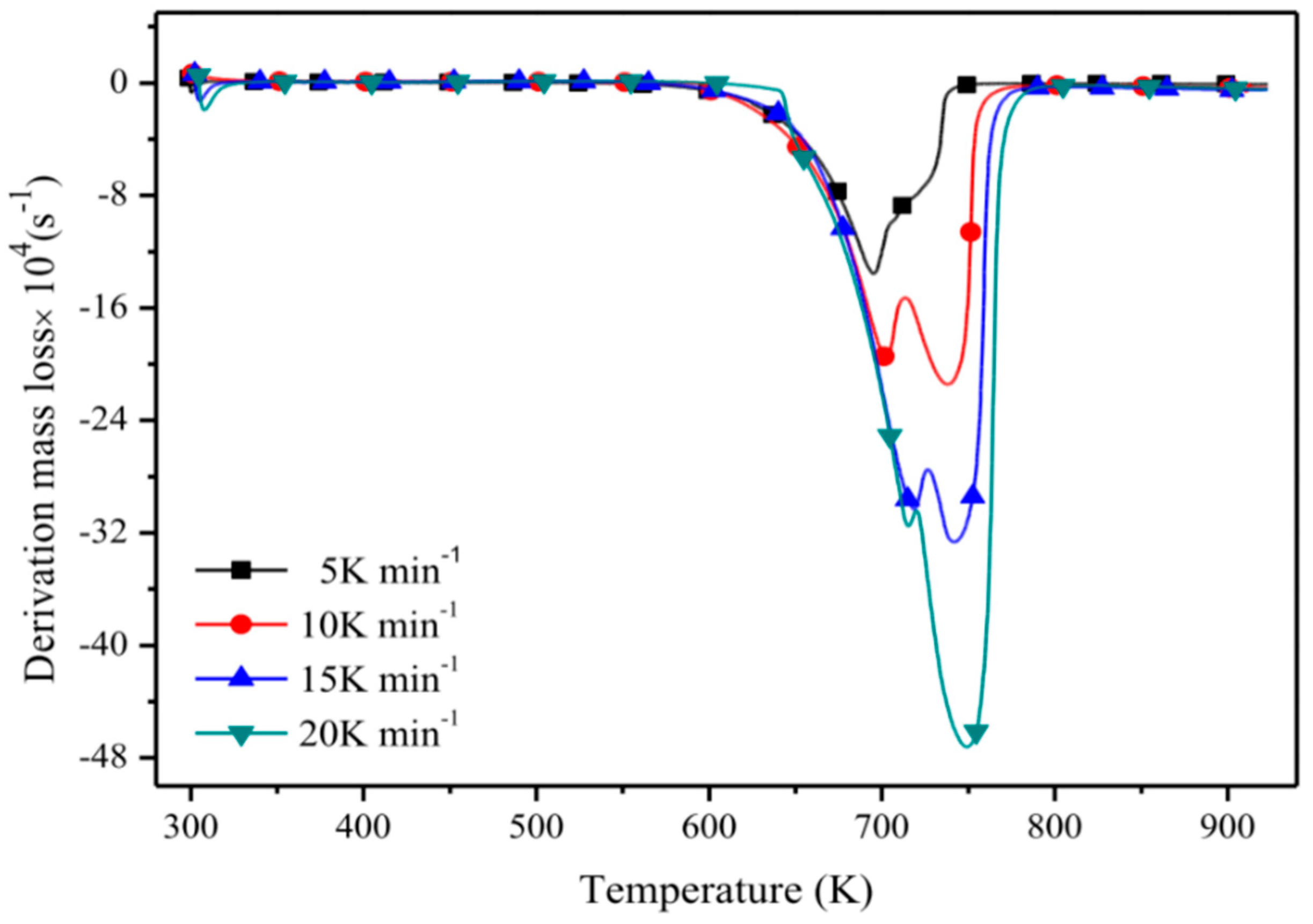
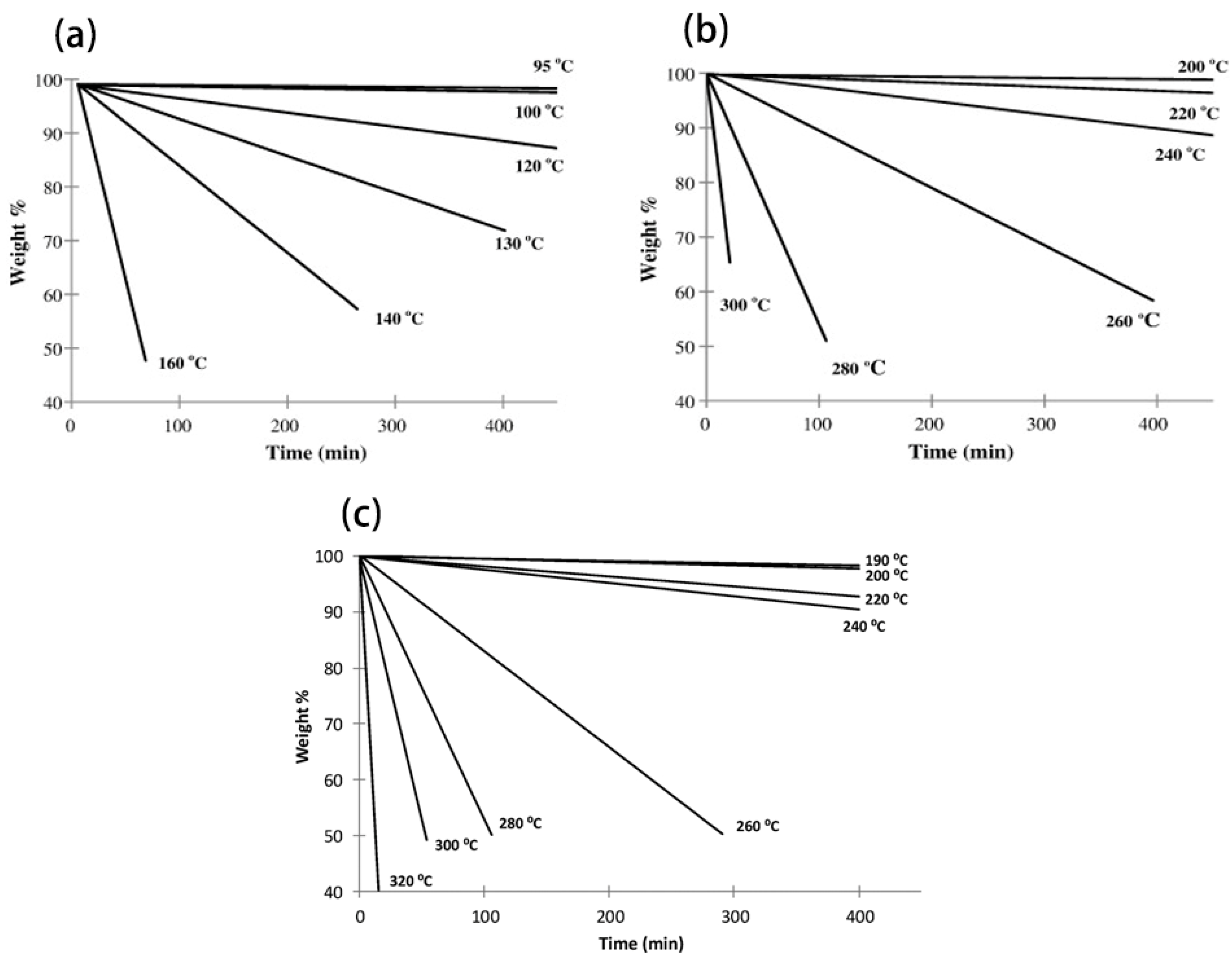
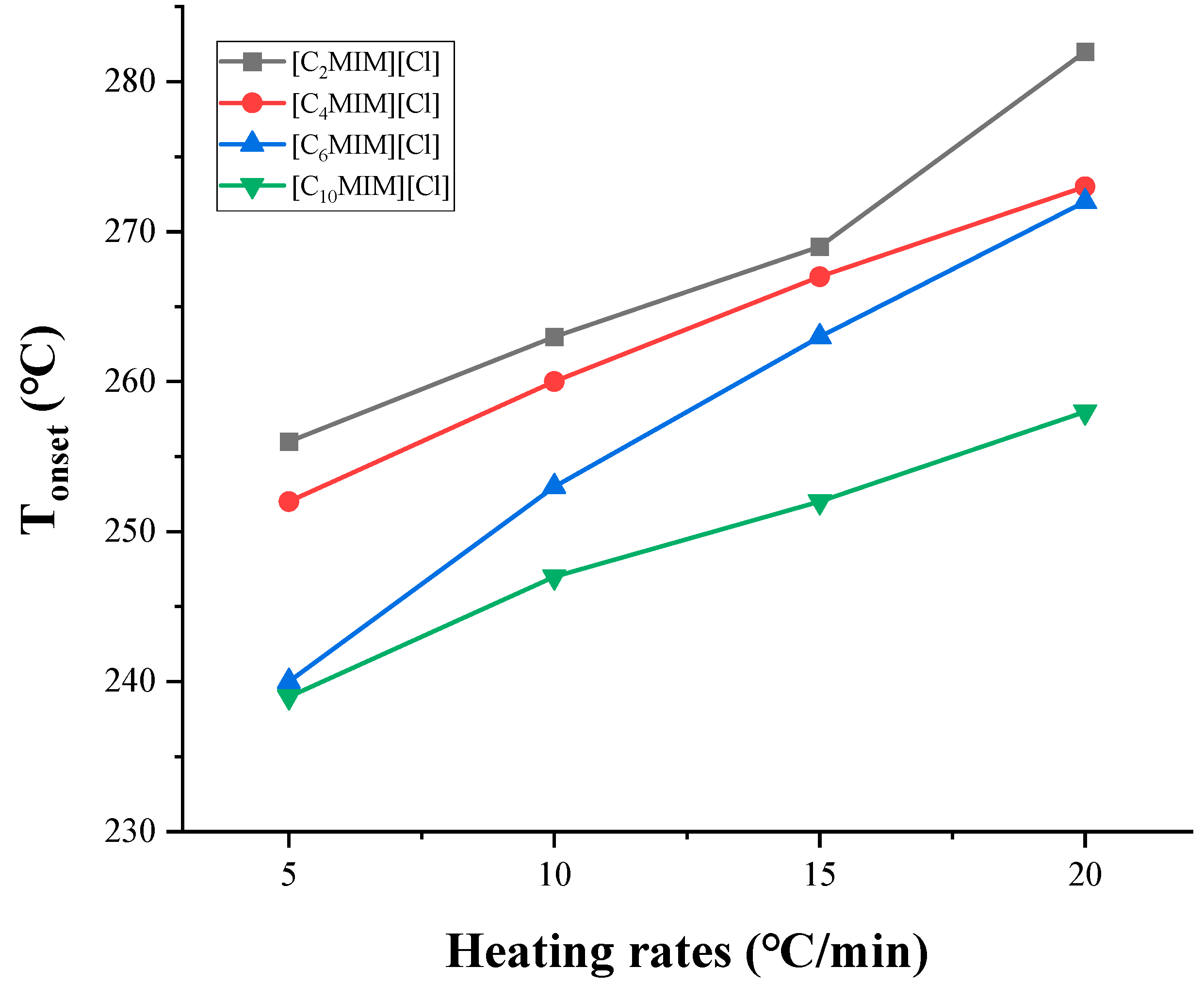
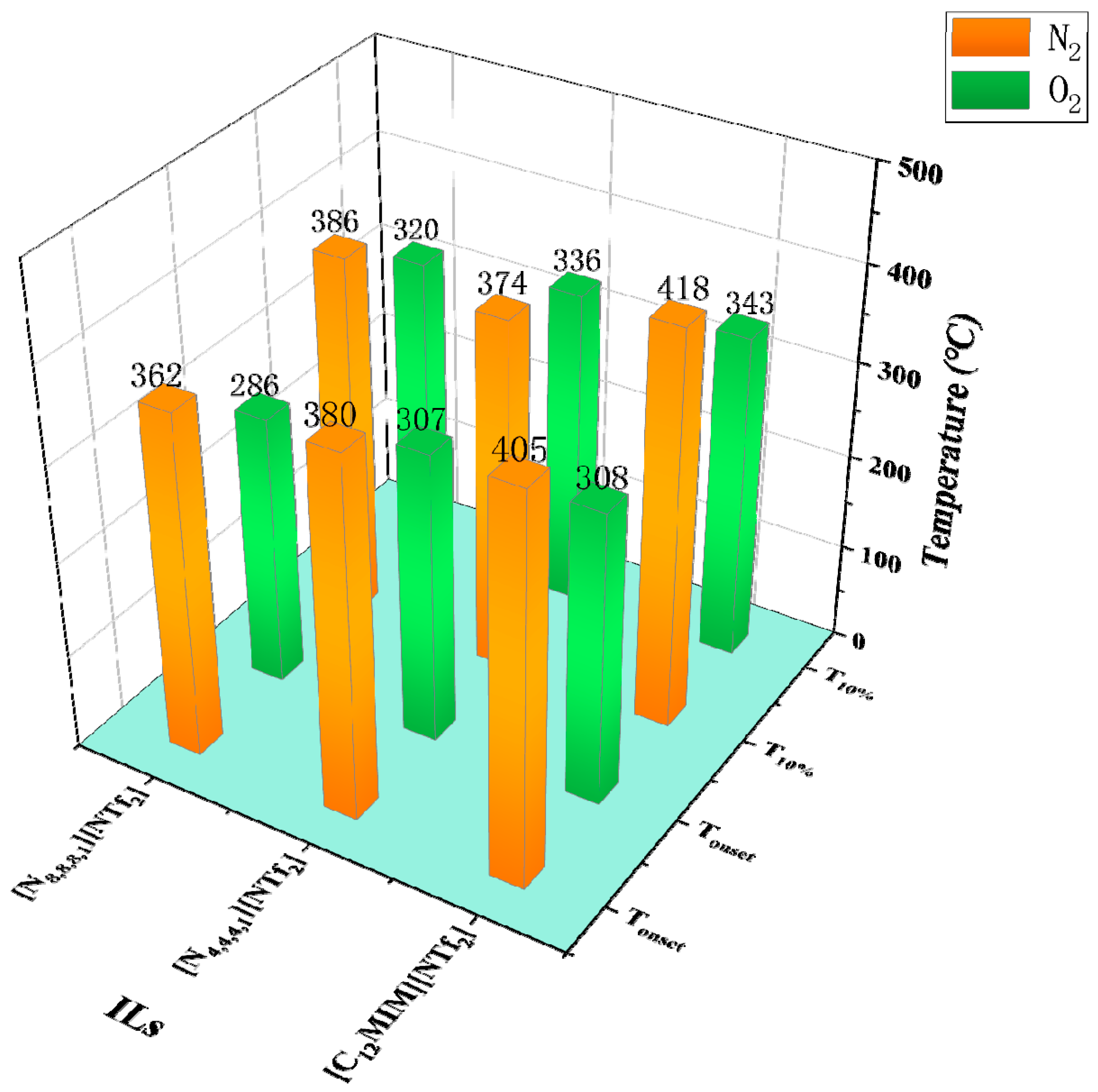
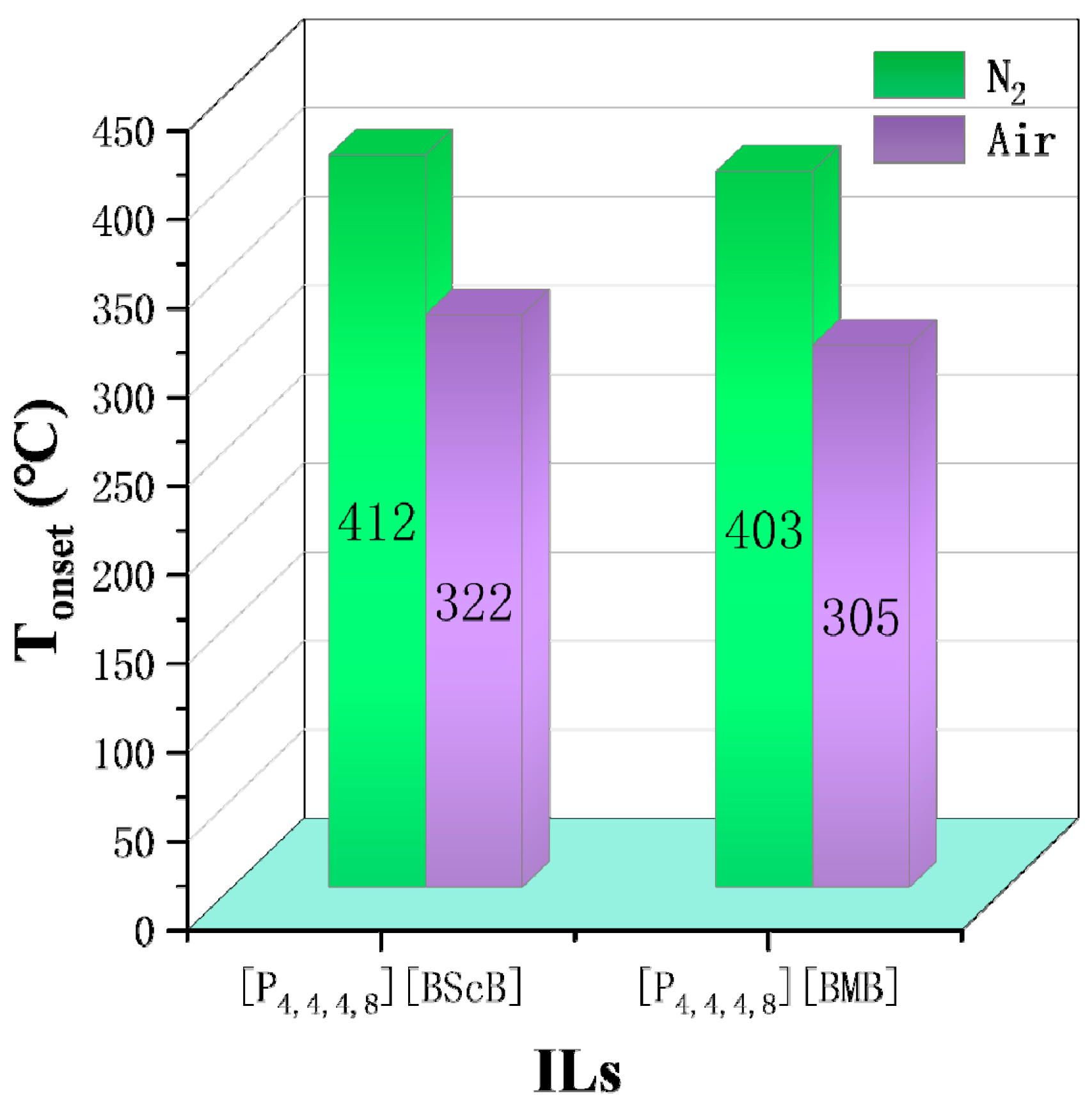
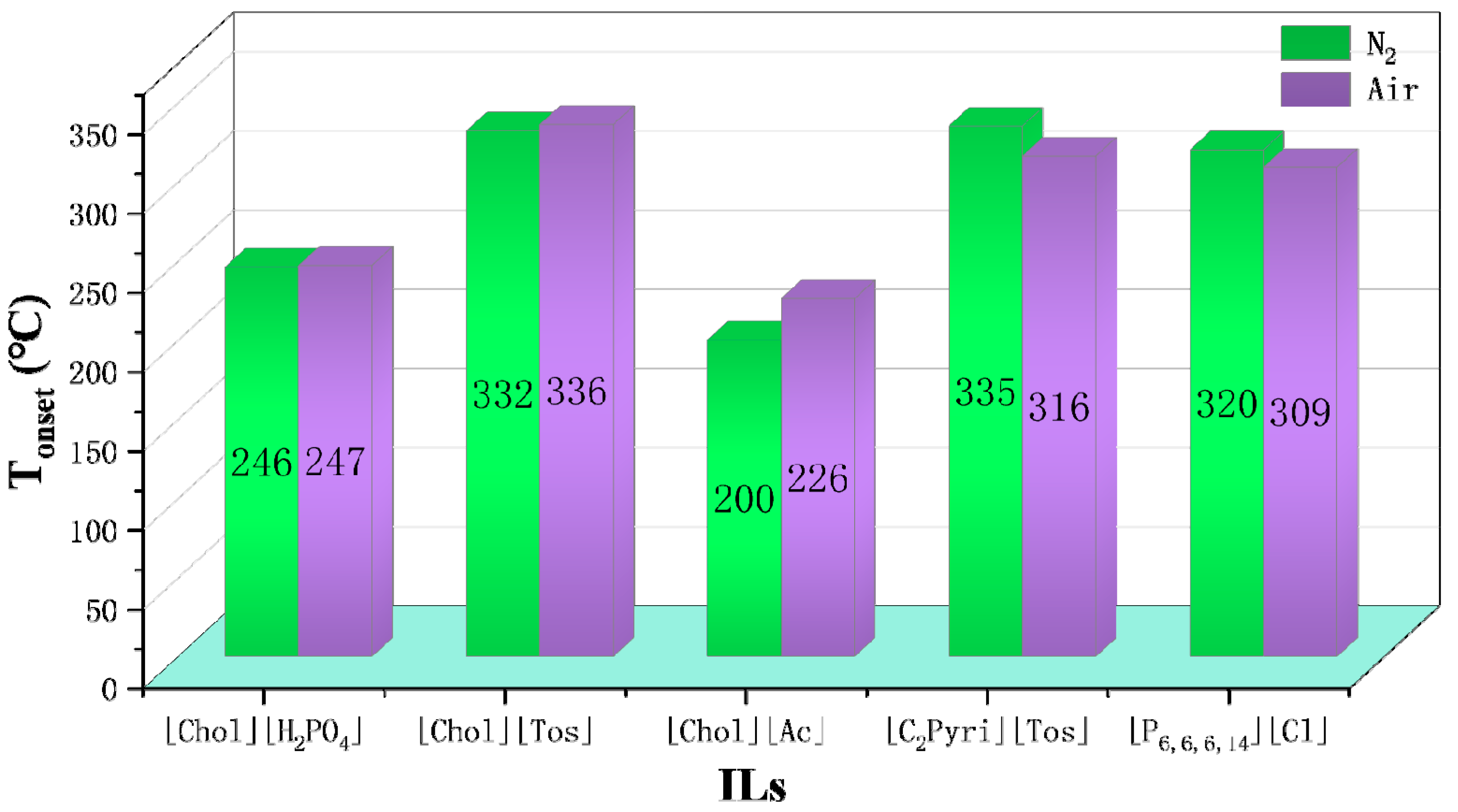

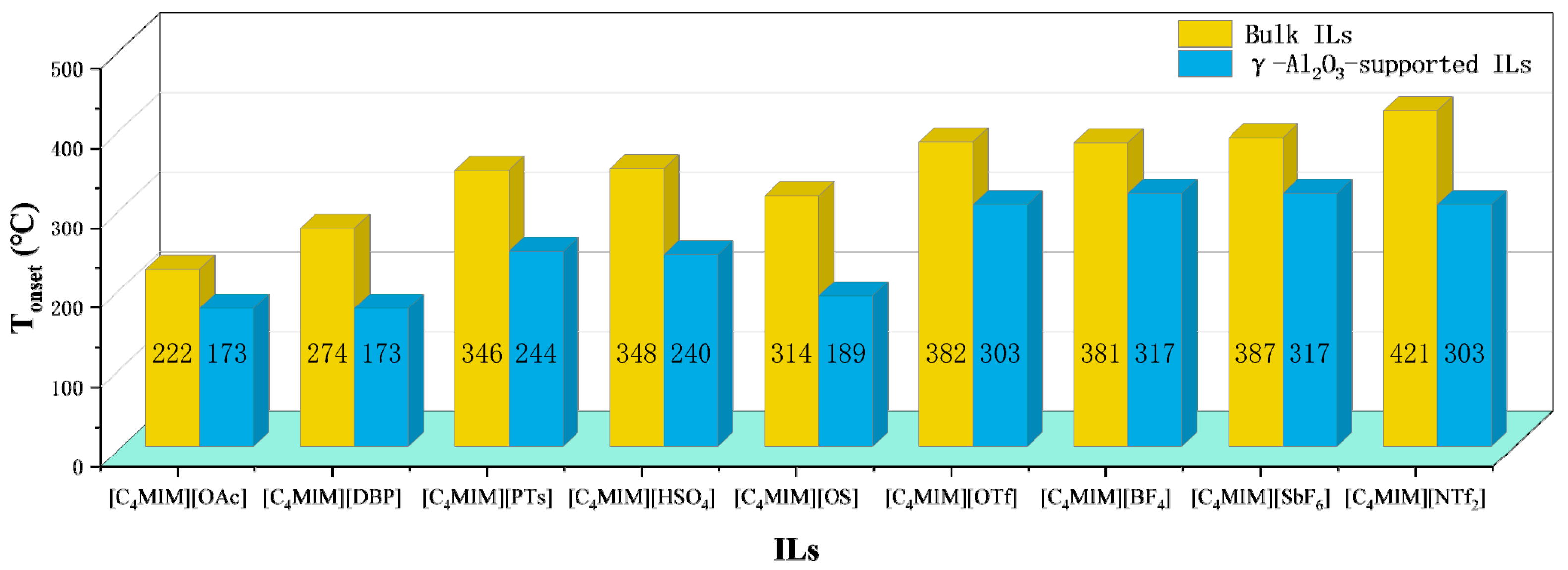
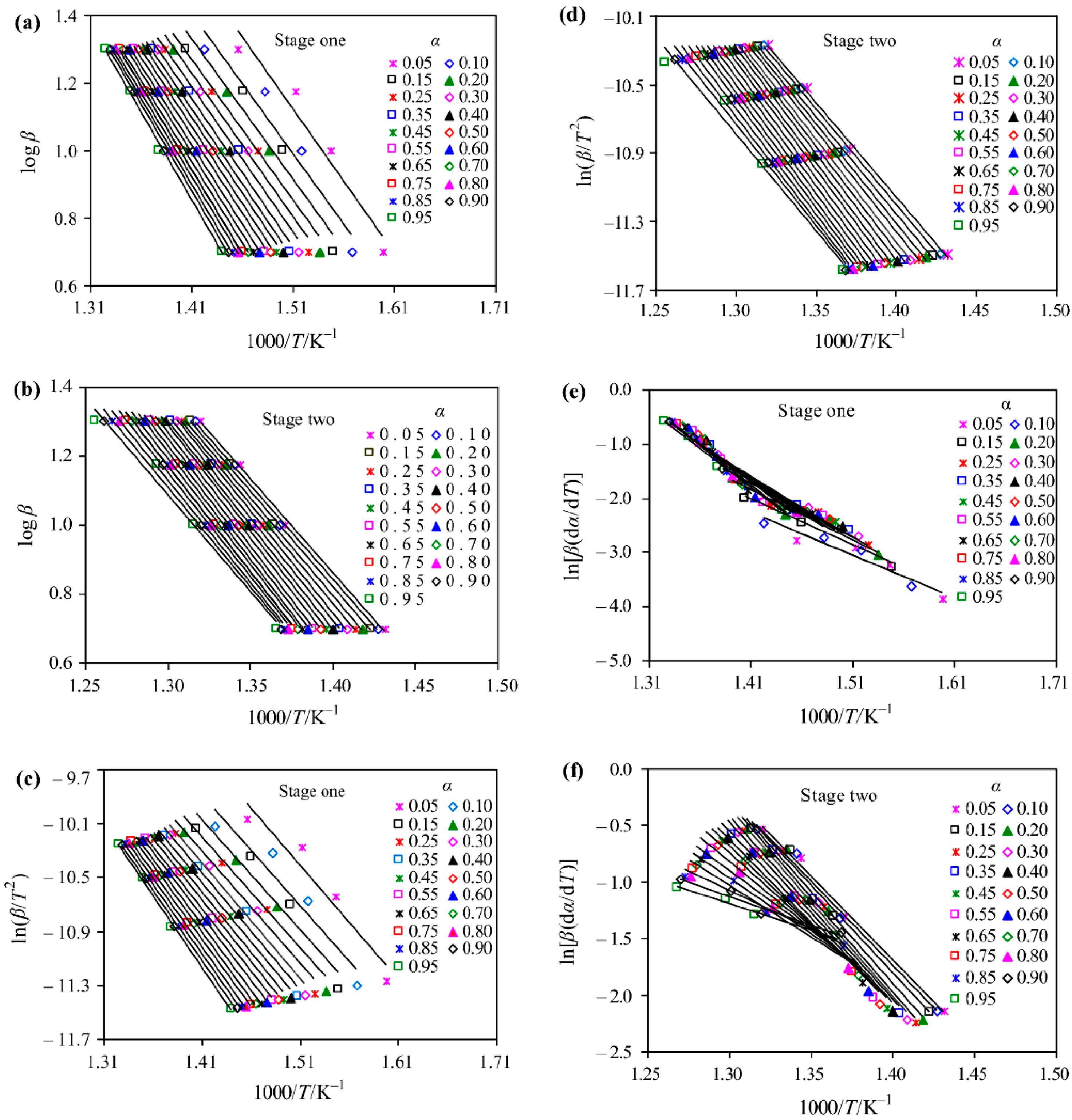
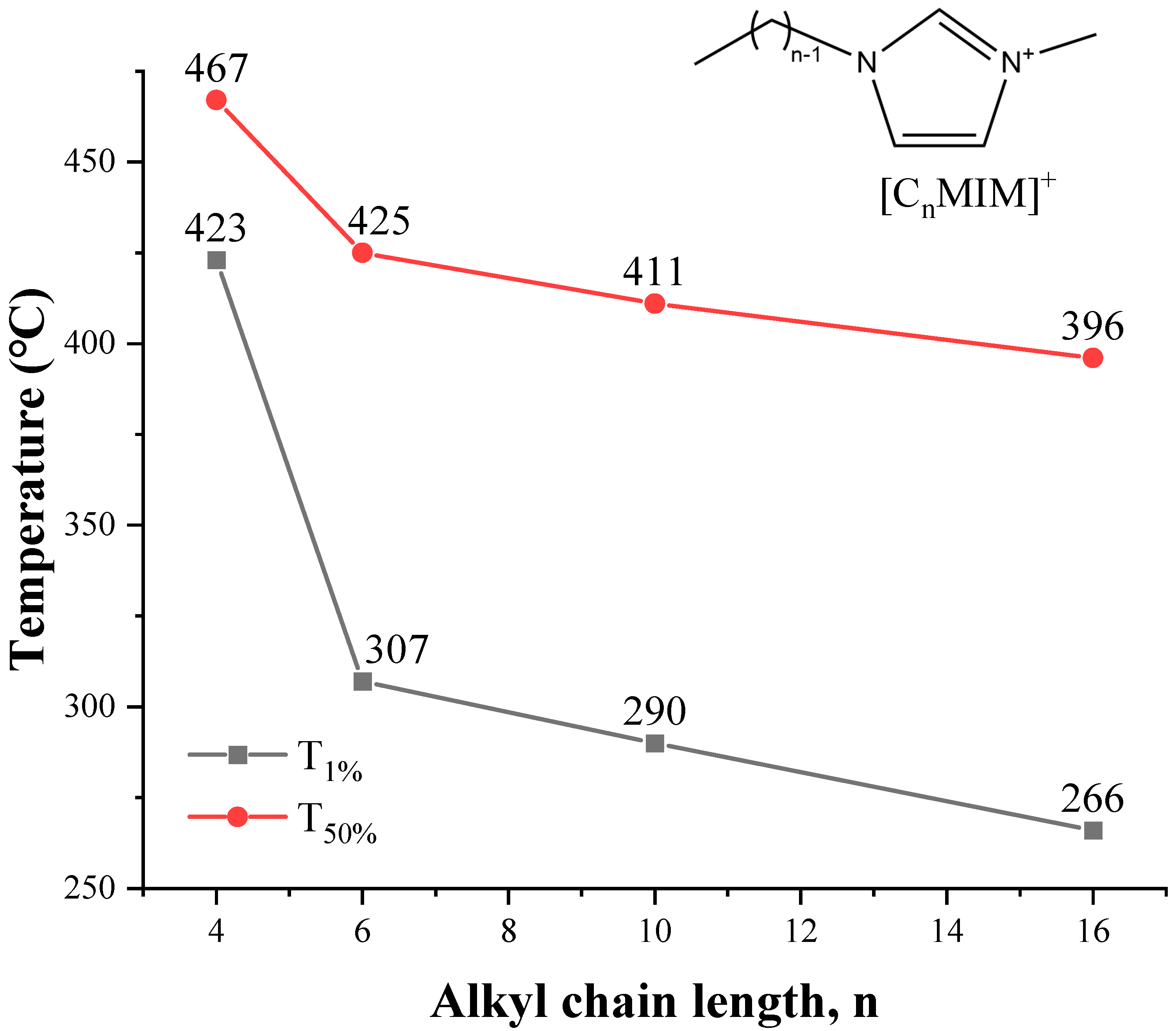
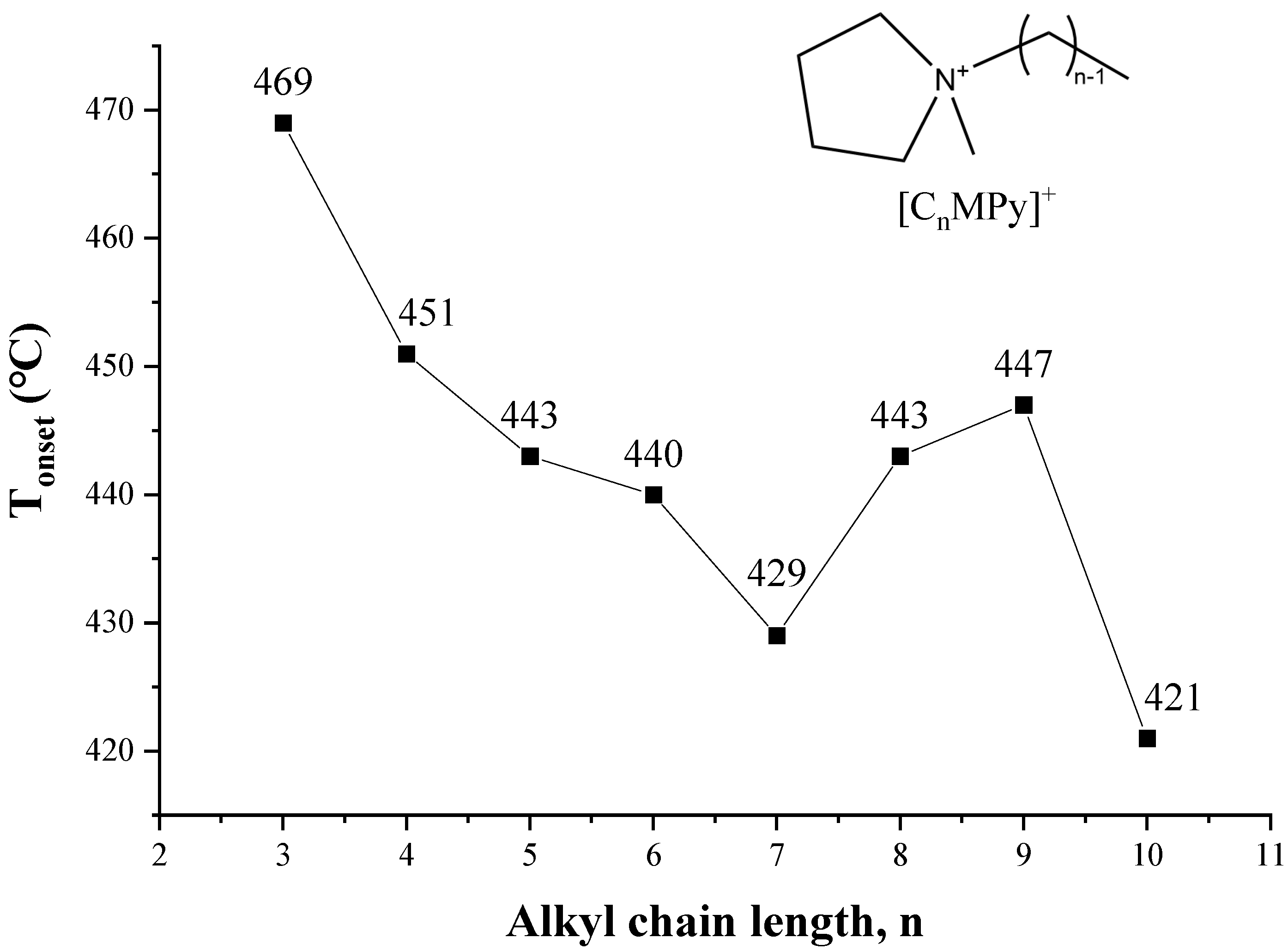

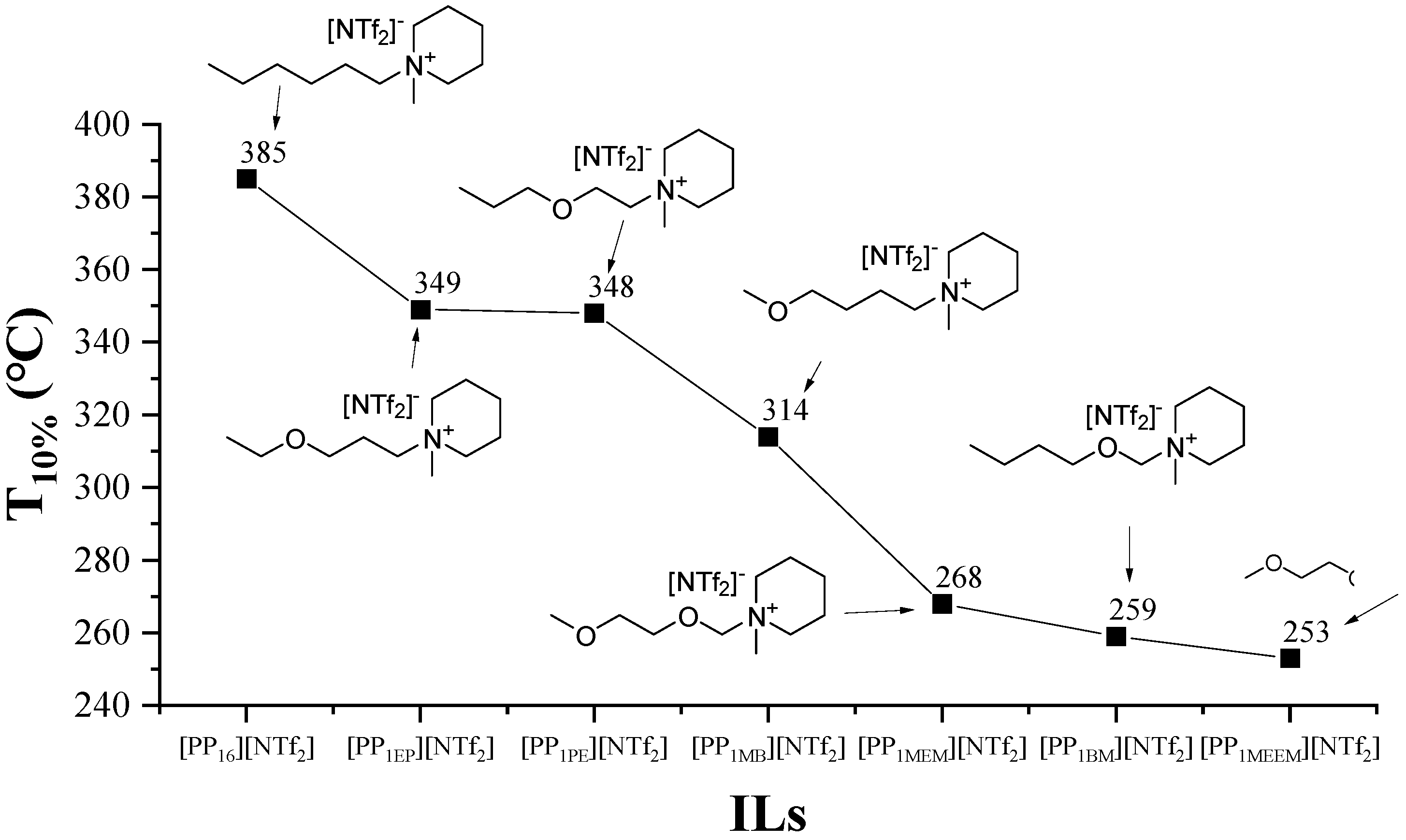

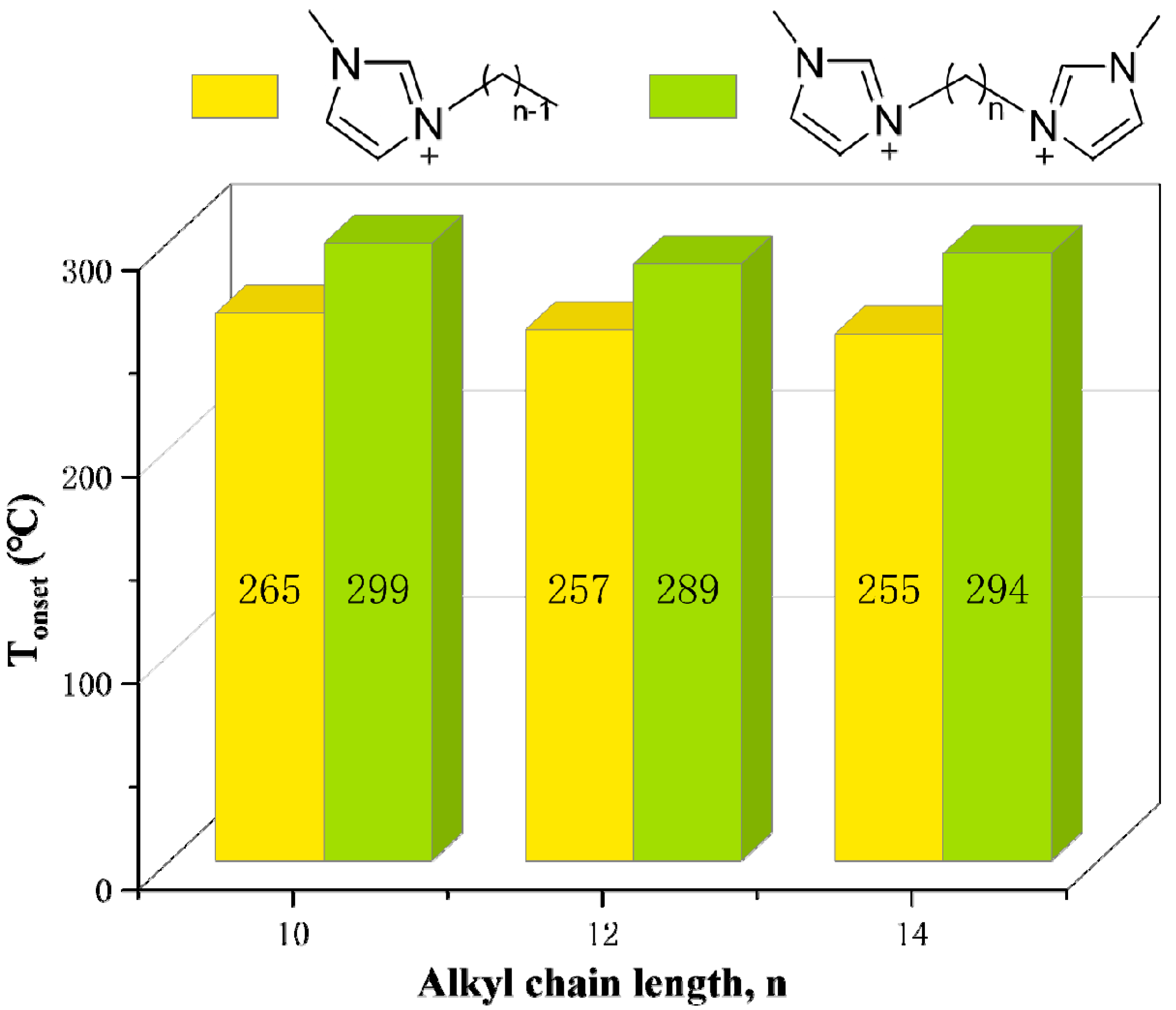

| Reaction Model | Code | f(α) |
|---|---|---|
| Power law | P2 | 2α1/2 |
| Power law | P3 | 3α2/3 |
| One-dimensional diffusion | D1 | 1/2α−1 |
| Two-dimensional diffusion | D2 | [−ln(1 − α)]−1 |
| Three-dimensional diffusion | D3 | 3/2(1 − α)2/3[1 − (1 − α)1/3]−1 |
| Zero-order | F0 | 1 |
| First-order | F1 | 1 − α |
| nth order | Fn | (1 – α)n |
| α | KAS | FWO | Starink | ||||
|---|---|---|---|---|---|---|---|
| /kJ mol−1 | R2 | mol −1 | R2 | mol −1 | R2 | ||
| 0.1 | 109.5 | 0.99 | 114.6 | 0.99 | 109.9 | 0.99 | |
| 0.2 | 116.9 | 0.99 | 121.9 | 0.99 | 117.3 | 0.99 | |
| 0.3 | 121.6 | 0.99 | 126.5 | 0.99 | 122.0 | 0.99 | |
| 0.4 | 121.3 | 0.99 | 126.4 | 0.99 | 121.7 | 0.99 | |
| 0.5 | 120.3 | 0.99 | 125.6 | 0.99 | 120.7 | 0.99 | |
| 0.6 | 116.7 | 0.99 | 122.2 | 0.99 | 117.1 | 0.99 | |
| 0.7 | 112.2 | 0.97 | 118.0 | 0.98 | 112.6 | 0.97 | |
| 0.8 | 108.8 | 0.97 | 114.9 | 0.97 | 109.2 | 0.97 | |
| Average | 115.9 | 121.3 | 116.3 | ||||
| ILs | Method | Eα/kJ mol−1 |
|---|---|---|
| [C4MIM][PF6] [55] | Vyazovkin | 77.52 |
| 101.22 | ||
| KAS | 76.83 | |
| 100.60 | ||
| [C2MIM][Cl] [57] | Vyazovkin | 120.8 |
| Starink | 121.6 | |
| [C3MIM][Cl] [57] | Vyazovkin | 151.5 |
| Starink | 155.0 | |
| [C4MIM][Cl] [57] | Vyazovkin | 146.8 |
| Starink | 150.8 | |
| [C6MIM][Cl] [57] | Vyazovkin | 98.6 |
| Starink | 97.9 | |
| [C10MIM][Cl] [57] | Vyazovkin | 148.2 |
| Starink | 149.7 |
| ILs | Method | Eα/kJ mol−1 |
|---|---|---|
| [C2MIM][Cl] [57] | Starink | 121.6 |
| Max-rate Starink | 114.6 | |
| [C3MIM][Cl] [57] | Starink | 155.0 |
| Max-rate Starink | 155.6 | |
| [C4MIM][Cl] [57] | Starink | 150.8 |
| Max-rate Starink | 136.6 | |
| [C6MIM][Cl] [57] | Starink | 97.9 |
| Max-rate Starink | 96.1 | |
| [C10MIM][Cl] [57] | Starink | 149.7 |
| Max-rate Starink | 139.9 | |
| [C4MPy][NTf2] [53] | FWO | 128.6 |
| Max-rate FWO | 149.20 | |
| KAS | 123.6 | |
| Max-rate KAS | 144.97 | |
| Starink | 124.0 | |
| Max-rate Starink | 144.30 |
| ILs | E/ kJ mol−1 | |||
|---|---|---|---|---|
| Non-Isothermal Methods | Isothermal Method | |||
| Friedman | KAS | FWO | Zero-Order Arrhenius Method | |
| [C2MIM][NTf2] | 102 ± 5 | 102 ± 7 | 108 ± 6 | 122 ± 11 |
| [C3MIM][NTf2] | 100 ± 7 | 92 ± 7 | 98 ± 7 | 125 ± 8 |
| [C4MIM][NTf2] | 130 ± 6 | 125 ± 5 | 130 ± 5 | 144 ± 8 |
| [C4MMIM][NTf2] | 118 ± 11 | 119 ± 13 | 124 ± 12 | 129 ± 5 |
| ILs | E/kJ mol−1 | A/min−1 | Method | Reference |
|---|---|---|---|---|
| [C2MIM][NTf2] | 317 | 7.2 × 1021 | First-order Arrhenius method | [100] |
| 131.6 | 1.716 × 1011 | Zero-order Arrhenius method | [74] | |
| 102 | - | KAS method | [44] | |
| [C4MIM][NTf2] | 287 | 7.2 × 1019 | First-order Arrhenius method | [100] |
| 126.4 | 3.047 × 1010 | Zero-order Arrhenius method | [74] | |
| 115.9 | - | KAS method | [18] |
| ILs | ln(A)* | ||
|---|---|---|---|
| Master Plots Method | Zero-Order Arrhenius Method | First-Order Arrhenius Method | |
| [C4MIM][Cl] | 34.9 [57] | 32.2 [74] | 20.4 [39] |
| ILs | Structure of Cations | T5%/°C |
|---|---|---|
| [ethoxyC5IM][NTf2] |  | 377.3 |
| [ethoxyiC5IM][NTf2] |  | 372.7 |
| [ethoxyneoC5IM][NTf2] |  | 369.8 |
| [ethoxycC5IM][NTf2] |  | 355.4 |
| [ethoxy3C5IM][NTf2] |  | 354.3 |
| [C4C5IM][NTf2] |  | 413.2 |
| [C4iC5IM][NTf2] |  | 402.3 |
| [C4cC5IM][NTf2] |  | 365.9 |
| [C43C5IM][NTf2] |  | 362.9 |
| ILs | Structure of Anions | Tonset/°C |
|---|---|---|
| 4-methyl-1-propyl-1,2,4-triazolium [NTf2] |  | 365 |
| 4-methyl-1-propyl-1,2,4-triazolium [OTf] |  | 330 |
| 4-methyl-1-propyl-1,2,4-triazolium [BF4] |  | 302 |
| 4-methyl-1-propyl-1,2,4-triazolium [PTs] |  | 291 |
| 4-methyl-1-propyl-1,2,4-triazolium [OMs] |  | 267 |
| 4-methyl-1-propyl-1,2,4-triazolium[I] | I- | 207 |
| 4-methyl-1-propyl-1,2,4-triazolium [NO3] |  | 198 |
| ILs | Structure of Anions | T5%/°C |
|---|---|---|
| [P4,4,4,14][PFOS] |  | 426 |
| [P4,4,4,14][NPf2] |  | 418 |
| [P4,4,4,14][NTf2] |  | 405 |
| [P4,4,4,14][FeCl4] |  | 401 |
| [P4,4,4,14][AOT] |  | 330 |
| [P4,4,4,14][OS] |  | 194 |
| ILs | Structure of Anions | Decomposition Temperature/°C |
|---|---|---|
| [C4CNAzp][OTf] |  | 332 |
| [C4CNAzp][PTs] | 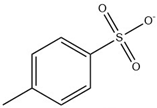 | 240 |
| [C4CNAzp][CH3SO4] |  | 234 |
| [C4CNAzp][OMs] |  | 220 |
| [C4CNAzp][Br] | Br- | 216 |
| [C4CNAzp][TFA] | 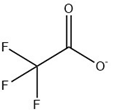 | 176 |
| DILs | Structure of Cations | T0.01/°C | T0.05/°C | T0.15/°C |
|---|---|---|---|---|
| [C32M(MMIM)2][NTf2]2 |  | 398 | 438 | 478 |
| [C32M(C1Py)2][NTf2]2 |  | 313 | 373 | 401 |
| [C32M(PC3C3C3)2][NTf2]2 |  | 355 | 402 | 434 |
| ILs | Structure of Cations | Tonset/°C |
|---|---|---|
| [C4(C2IM)2][Br]2 |  | 277.33 |
| [C4(C2H4IM)2][Br]2 |  | 304.36 |
| [C4(C2H5OIM)2][Br]2 |  | 297.65 |
| [C4(C2H3O2IM)2][Br]2 |  | 309.43 |
| DILs | Decomposition Temperature/°C |
|---|---|
| [Pyri(C8MIM)2][Cl]2 | 273.2 a |
| [Pyri(C8MIM)2][OTf]2 | 417.8 a |
| [Pyri(C8MIM)2][BF4]2 | 419.1 a |
| [Pyri(C8MIM)2][PF6]2 | 429.4 a |
| [Pyri(C8MIM)2][NTf2]2 | 443.5 a |
| [C4(MIM)2][BF4]2 | 384.6 b |
| [C4(MIM)2][PF6]2 | 423.4 b |
| [C4(MIM)2][NTf2]2 | 468.1 b |
| No. | ILs | Tonset/°C | T5%/°C | T10%/°C | Tpeak/°C | E/kJ mol−1 | Ref. |
|---|---|---|---|---|---|---|---|
| Monocationic ILs | |||||||
| 1 | [C2MIM][Cl] | 263 | 122 a | [57] | |||
| 260 | 120 b | [39] | |||||
| 2 | [C3MIM][Cl] | 246 | 155 a | [57] | |||
| 3 | [C4MIM][Cl] | 260 | 151 a | [57] | |||
| 250 | 105 b | [39] | |||||
| 4 | [C4MMIM][Cl] | 267 | 58.688 b | [86] | |||
| 5 | [C6MIM][Cl] | 253 | 98 a | [57] | |||
| 6 | [C10MIM][Cl] | 247 | 150 a | [57] | |||
| 7 | [C3OHMIM][Cl] | 295 | [113] | ||||
| 8 | [P6,6,6,14][Cl] | 320 | [40] | ||||
| 9 | [C2MIM][Br] | 283 | 125 b | [39] | |||
| 10 | [C4MIM][Br] | 255 | 127 b | [39] | |||
| 11 | [C10MIM][Br] | 265 | 298 | [134] | |||
| 12 | [C12MIM][Br] | 257 | 292 | [134] | |||
| 13 | [C14MIM][Br] | 255 | 287 | [134] | |||
| 14 | [C2NH2MIM][Br] | 222 | [113] | ||||
| 15 | [C4CNAzp][Br] | 216 | [123] | ||||
| 16 | [C2MIM][I] | 279 | 111 b | [39] | |||
| 17 | [C4MIM][I] | 265 | 121 b | [39] | |||
| 18 | [C3MT1,2,4M][I] | 207 | 188 | 122.1 c | [78] | ||
| 19 | [C2MIM][NTf2] | 425 | 384 | 402 | 470 | 102 b; 108 d | [44] |
| 20 | [C3MIM][NTf2] | 406 | 358 | 379 | 448 | 92 b; 98 d | [44] |
| 412 | 369 | 115.8 c | [78] | ||||
| 21 | [C4MIM][NTf2] | 426 | 385 | 405 | 466 | 125 b; 130 d | [44] |
| 421 | 478 | [58] | |||||
| 367 | 465 | 115.9 b;121.3 d; 116.3 a | [18] | ||||
| 418 | 385 | 130.7 c | [75] | ||||
| 22 | [C4MMIM][NTf2] | 418 | 374 | 394 | 468 | 119 b; 124 d | [44] |
| 436 | 408 | 478 | 129 c | [47] | |||
| 23 | [C7MIM][NTf2] | 437 | 426 | 464 | [110] | ||
| 24 | [C12MIM][NTf2] | 405 | 418 | 464 | 125 b | [49] | |
| 25 | [N4,4,4,1][NTf2] | 380 | 374 | 435 | 121 b | [49] | |
| 26 | [N8,8,8,1][NTf2] | 362 | 386 | 425 | 108 b | [49] | |
| 27 | [P4,4,4,14][NTf2] | 405 | [37] | ||||
| 28 | [C3MPy][NTf2] | 469 | [72] | ||||
| 29 | [C4MPy][NTf2] | 451 [66] | 450 | 128.6 d; 123.6 b; 124.0 a [50] | |||
| 30 | [C5MPy][NTf2] | 443 | [72] | ||||
| 31 | [C6MPy][NTf2] | 440 | [72] | ||||
| 32 | [C7MPy][NTf2] | 429 | [72] | ||||
| 33 | [C8MPy][NTf2] | 443 [66] | 447 [50] | 113.7 d; 107.8 b; 108.2 a [50] | |||
| 34 | [C9MPy][NTf2] | 447 | [72] | ||||
| 35 | [C10MPy][NTf2] | 421 | [72] | ||||
| 36 | [C1OC2MPy][NTf2] | 411 | 399 | 443 | [63] | ||
| 37 | [C2MT1,2,4M][NTf2] e | 355 | 327 | 102.5 c | [75] | ||
| 38 | [C3MT1,2,4M][NTf2] e | 365 | 337 | 110.3 c | [75] | ||
| 39 | [C4MT1,2,4M][NTf2] e | 350 | 327 | 114.8 c | [75] | ||
| 40 | [C6MT1,2,4M][NTf2] e | 345 | 318 | 119.1 c | [75] | ||
| 41 | [C8MT1,2,4M][NTf2] e | 346 | 318 | 123.6 c | [75] | ||
| 42 | [C10MT1,2,4M][NTf2] e | 357 | 331 | 127.7 c | [75] | ||
| 43 | [C12MT1,2,4M][NTf2] e | 354 | 326 | 131.6 c | [75] | ||
| 44 | [BnzMIM][NTf2] | 421 | 402 | 464 | [110] | ||
| 45 | [(Bnz)2IM][NTf2] | 410 | 391 | 453 | [110] | ||
| 46 | [NapmMIM][NTf2] | 406 | 392 | 460 | [110] | ||
| 47 | [PP16][NTf2] | 385 | [117] | ||||
| 48 | [PP1EP][NTf2] | 349 | [117] | ||||
| 49 | [PP1PE][NTf2] | 348 | [117] | ||||
| 50 | [PP1MB][NTf2] | 314 | [117] | ||||
| 51 | [PP1MEM][NTf2] | 268 | [117] | ||||
| 52 | [PP1BM][NTf2] | 259 | [117] | ||||
| 53 | [PP1MEEM][NTf2] | 253 | [117] | ||||
| 54 | [ethoxyC5IM][NTf2] | 377.3 | [66] | ||||
| 55 | [ethoxyiC5IM][NTf2] | 372.7 | [66] | ||||
| 56 | [ethoxyneoC5IM][NTf2] | 369.8 | [66] | ||||
| 57 | [ethoxycC5IM][NTf2] | 355.4 | [66] | ||||
| 58 | [ethoxy3C5IM][NTf2] | 354.3 | [66] | ||||
| 59 | [C4C5IM][NTf2] | 413.2 | [66] | ||||
| 60 | [C4iC5IM][NTf2] | 402.3 | [66] | ||||
| 61 | [C4cC5IM][NTf2] | 365.9 | [66] | ||||
| 62 | [C43C5IM][NTf2] | 362.9 | [66] | ||||
| 63 | [C4MIM][PTs] | 346 | 379 | [58] | |||
| 64 | [C3MT1,2,4M][PTs] e | 291 | 271 | 141.8 c | [78] | ||
| 65 | [C4CNAzp][PTs] | 240 | [123] | ||||
| 66 | [Chol][Tos] | 332 | 346 | [73] | |||
| 67 | [C2Py][Tos] | 335 | 357 | [73] | |||
| 68 | [Chol][Ac] | 200 | 222 | [73] | |||
| 69 | [C2MIM][Ac] | 221 | [85] | ||||
| 70 | [C4MIM][OS] | 314 | 353 | [58] | |||
| 71 | [P4,4,4,14][OS] | 194 | [37] | ||||
| 72 | [MIM][NO3] | 163 | 184 | 112.7 d | [90] | ||
| 73 | [C3MT1,2,4M][NO3] e | 198 | 187 | 132.1 c | [78] | ||
| 74 | [C3MT1,2,4M][OMs] e | 267 | 254 | 138.9 c | [78] | ||
| 75 | [C4CNAzp][OMs] | 220 | [123] | ||||
| 76 | [C4MIM][OTf] | 382 | 420 | [58] | |||
| 77 | [C4MMIM][OTf] f | 436 | 424 | 479 | 148 c | [47] | |
| 78 | [C3MT1,2,4M][OTf] e | 365 | 337 | 110.3 c | [78] | ||
| 79 | [C4CNAzp][OTf] | 332 | [123] | ||||
| 80 | [C4MIM][BF4] | 381 | 396 | [58] | |||
| 81 | [C2MMIM][BF4] | 391 | [101] | ||||
| 82 | [C2NH2MMIM][BF4] | 284 | 72.2 c | [101] | |||
| 83 | [C3MT1,2,4M][BF4] e | 302 | 264 | 102.2 c | [78] | ||
| 84 | [C1OC2MPy][(C2F5)3PF3] | 352 | 349 | 384 | [63] | ||
| 85 | [P6,6,6,14][(C2F5)3PF3] | 363 | 356 | 396 | [63] | ||
| 86 | [C4MIM][DBP] | 274 | 293 | [58] | |||
| 286 | 157.88 a | [56] | |||||
| 87 | [C4MIM][AcO] | 222 | 246 | [58] | |||
| 88 | [P6,6,6,14][AcO] | 275.8 | 259.3 | [83] | |||
| 89 | [P6,6,6,14][ButO] | 270.6 | 248.3 | [83] | |||
| 90 | [P6,6,6,14][HexO] | 255.8 | 233.9 | [83] | |||
| 91 | [P6,6,6,14][OctO] | 242.8 | 219.6 | [83] | |||
| 92 | [P6,6,6,14][DecO] | 268.8 | 260.4 | [83] | |||
| 93 | [P4,4,4,8][BScB] | 412 | 430 | [81] | |||
| 94 | [P4,4,4,8][BMB] | 403 | 430 | [81] | |||
| 95 | [Chol][H2PO4] | 246 | 335 | [73] | |||
| 96 | [C4MIM][HSO4] | 348 | 389 | [58] | |||
| 97 | [C4MIM][SbF6] | 387 | 413 | [58] | |||
| 98 | [C4MIM][PF6] | 412 | 386 | 399 | 461 | 100.60 b; 107.36 d | [55] |
| 99 | [BSMBIM][CF3SO3] | 331 | 359 | 171.01 b; 171.30 a | [54] | ||
| 100 | [C4MMIM][FAP] | 376 | 379 | 402 | 139 c | [47] | |
| 101 | [P4,4,4,14][PFOS] | 426 | [37] | ||||
| 102 | [P4,4,4,14][NPf2] | 418 | [37] | ||||
| 103 | [P4,4,4,14][FeCl4] | 401 | [37] | ||||
| 104 | [P4,4,4,14][AOT] | 330 | [37] | ||||
| 105 | [C4CNAzp][CH3SO4] | 234 | [123] | ||||
| 106 | [C4CNAzp][TFA] | 176 | [123] | ||||
| Dicationic ILs | |||||||
| 107 | [C2(MIM)2][Br]2 | 311 | [139] | ||||
| 108 | [C2(C2IM)2][Br]2 | 305 | [139] | ||||
| 109 | [C2(C3IM)2][Br]2 | 299 | [139] | ||||
| 110 | [C2(C4IM)2][Br]2 | 280 | [139] | ||||
| 111 | [C4(C2IM)2][Br]2 | 277 | [139] | ||||
| 112 | [C10(MIM)2][Br]2 | 299 | 317 | [134] | |||
| 113 | [C12(MIM)2][Br]2 | 289 | 309 | [134] | |||
| 114 | [C14(MIM)2][Br]2 | 294 | 315 | [134] | |||
| 115 | [C4(C2H4IM)2][Br]2 | 304 | [139] | ||||
| 116 | [C4(C2H5OIM)2][Br]2 | 298 | [139] | ||||
| 117 | [C4(C2H3O2IM)2][Br]2 | 309 | [139] | ||||
| 118 | [C4(MIM)2][Br]2 | 320 | [129] | ||||
| 119 | [C4(C2IM)2][Br]2 | 309 | [129] | ||||
| 120 | [C4(C3IM)2][Br]2 | 299 | [129] | ||||
| 121 | [C4(C4IM)2][Br]2 | 281 | [129] | ||||
| 122 | [Pyri(C8MIM)2][Cl]2 | 273 | [141] | ||||
| 123 | [Pyri(C8MIM)2][OTf]2 | 418 | [141] | ||||
| 124 | [Pyri(C8MIM)2][PF6]2 | 429 | [141] | ||||
| 125 | [C4(MIM)2][PF6]2 | 423 | [129] | ||||
| 126 | [C4(MIM)2][NTf2]2 | 468 | [129] | ||||
| 127 | [C32M(MMIM)2][NTf2]2 | 438 | [69] | ||||
| 128 | [C32M(C1Py)2][NTf2]2 | 373 | [69] | ||||
| 129 | [C32M(PC3C3C3)2][NTf2]2 | 402 | [69] | ||||
| 130 | [Pyri(C8MIM)2][NTf2]2 | 444 | [141] | ||||
Publisher’s Note: MDPI stays neutral with regard to jurisdictional claims in published maps and institutional affiliations. |
© 2021 by the authors. Licensee MDPI, Basel, Switzerland. This article is an open access article distributed under the terms and conditions of the Creative Commons Attribution (CC BY) license (http://creativecommons.org/licenses/by/4.0/).
Share and Cite
Xu, C.; Cheng, Z. Thermal Stability of Ionic Liquids: Current Status and Prospects for Future Development. Processes 2021, 9, 337. https://doi.org/10.3390/pr9020337
Xu C, Cheng Z. Thermal Stability of Ionic Liquids: Current Status and Prospects for Future Development. Processes. 2021; 9(2):337. https://doi.org/10.3390/pr9020337
Chicago/Turabian StyleXu, Chenqian, and Zhenmin Cheng. 2021. "Thermal Stability of Ionic Liquids: Current Status and Prospects for Future Development" Processes 9, no. 2: 337. https://doi.org/10.3390/pr9020337
APA StyleXu, C., & Cheng, Z. (2021). Thermal Stability of Ionic Liquids: Current Status and Prospects for Future Development. Processes, 9(2), 337. https://doi.org/10.3390/pr9020337






